If you’re considering planting a hedge, you probably already know that a hedge — a dense row of shrubs or low trees — can be a classy yet economical alternative to a fence, providing privacy, screening, and a host of other great benefits.
A hedge enhances a garden’s appearance and brings many other lifestyle and environmental benefits as well.
This blog will discuss which hedging plants work best here in Perth, and highlight other key considerations in hedging projects.
Not only that, but for comprehensive advice on garden design and plant selection, you can always reach out to our experienced team at Perth Landscaping Experts!
We’d love to help you make a great garden design decision, so your future garden is beautiful, manageable, liveable and sustainable.
If that’s what you want, read on to decide whether hedging is for you!

Reasons to Grow Hedging
Homeowners plant hedges for various reasons — we’ll cover some of the main ones, to help you clarify what you want to achieve, and what to grow.
For Aesthetic Appeal
A hedge can transform your garden, adding structure, visual contrast and a stylish look.
Whether your garden style is formal, contemporary, native or “cottage”, a well-designed hedge with complementary plantings can lift it out of the ordinary.
To Add Value
Property buyers pay more for established, landscaped gardens and experts estimate that hedging adds around 4% to the sale price.
To Disguise Flaws
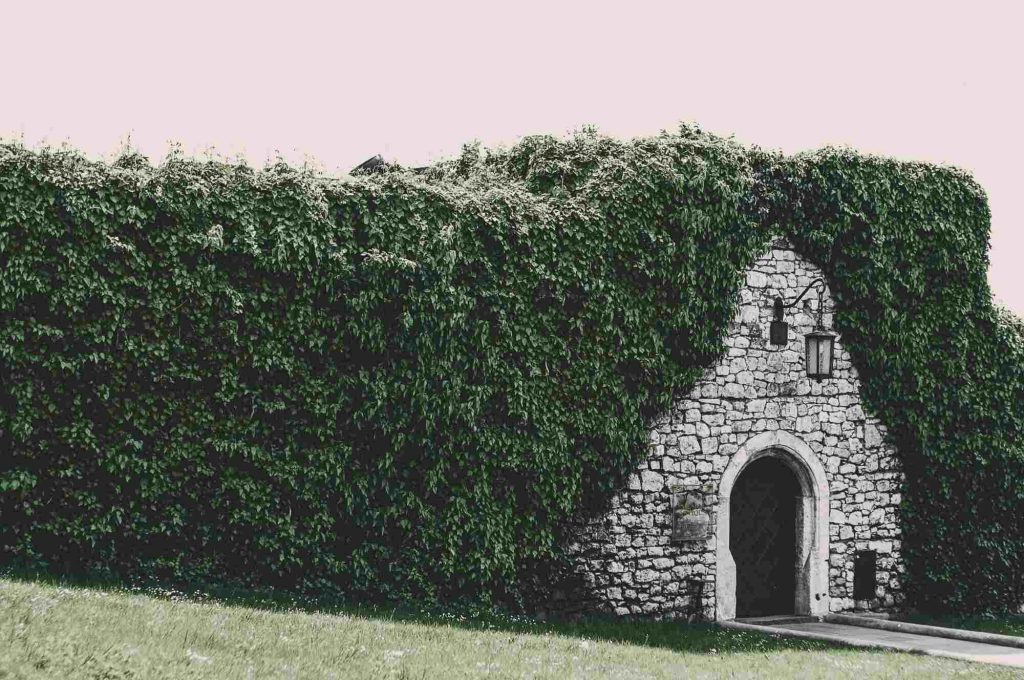
As well as being integral to many stunning garden designs, a hedge can also hide flaws. It can be less expensive than replacing an unsightly wall or fence.
Hedging can screen visually unappealing objects like sheds, clotheslines, solenoid boxes, and air-conditioners (remember, maintain access where needed and always consider the root systems and mature growth of whatever you plant).
For Security
Hedging creates a dense barrier, far more difficult for intruders to breach than a normal fence.
A hedge makes your home safer, without it looking like a fortress!
For Privacy
A hedge can provide privacy for your front garden, or around areas where privacy is particularly important, like your pool.
Councils place height restrictions on fences. Anything above 1.2 metres must be ‘visually permeable’. This makes privacy hard to achieve.
A hedge need not be ‘visually permeable’ and is often permitted to exceed the usual fence height.
Clarify what is permitted with your local council.
To Minimise Noise and Pollution
All plants provide environmental benefits, and improve quality of life, cooling, hydrating and purifying the air.
Researchers have found another benefit of hedges — noise reduction.
On busy roads a hedge can be particularly useful, absorbing noise and air pollution.
As A Windbreak
Hedges were traditionally grown in cold climates for protection from icy winds.
In Perth’s climate, a hedge can also shelter your home and garden from hot, dusty, salty winds. It can help to create a microclimate where delicate plants thrive.
To Keep Animals In or Out
A strategically planted hedge can help keep pets and children from wandering. It can also keep unwanted animals out — the neighbour’s dog won’t be digging up your precious garden!
To Attract Wildlife
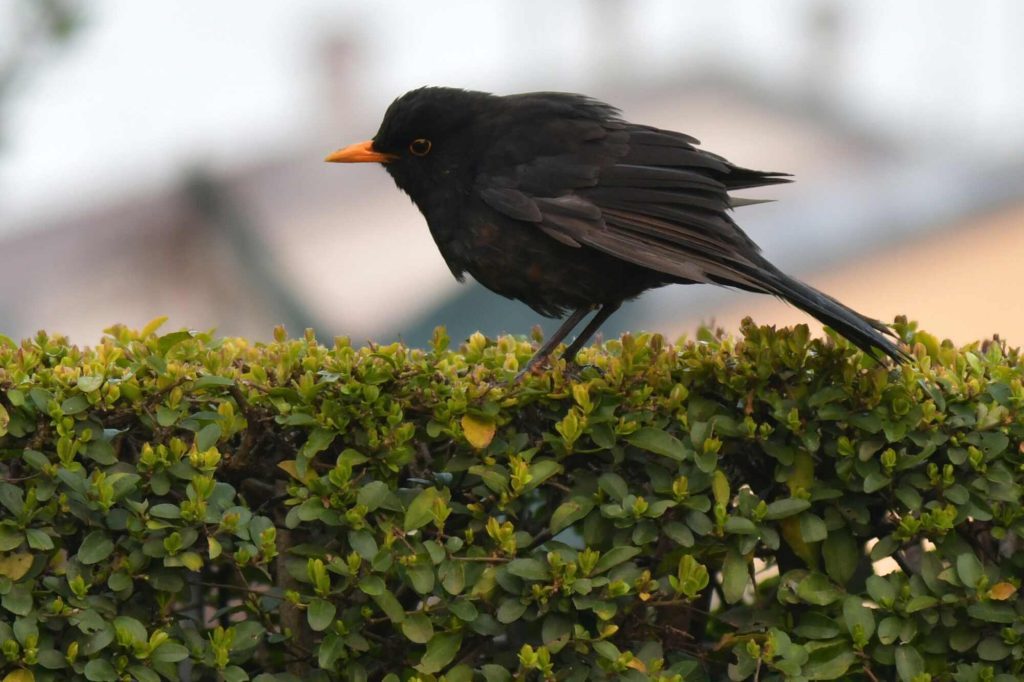
Birds and other wildlife like tree frogs inhabit hedges, feeding on insects before they become garden pests. Flowering hedges attract bees and butterflies, making your garden more environmentally friendly.
Choosing the Right Hedging Plants
So, you’ve decided hedging is for you. What next?
We recommend you design your hedge to complement your existing home and garden. Or for new builds, create a ‘whole garden’ concept before planning your hedge.
Whether you’re hoping to achieve security, privacy, shelter, aesthetics, or just want to hear more birdsong, hedging and companion plants that complement one another will give a more harmonious outcome!
Planning and execution are both crucial to achieving your ideal look and result.
The process is not always straightforward though, so we recommend you seek help when deciding on the right heading plants. This will ensure you choose plants that look beautiful and suit our climate and soil! You may even want to seek expert advice on soil preparation before you begin.
Best Hedging Plants in Perth
In this post, our focus is on helping you become familiar with hedging plants that thrive in Perth.
Issues to consider when selecting plants will include:
- your purpose in planting the hedge
- your garden’s size, layout, and style
- your budget.
Also consider whether you want hedging plants that:
- attract birds and bees (choose fragrant flowers for this)
- create less leaf and petal litter (this helps keep your pool clean!)
- are drought resistant and need less hand-watering
- have non-invasive roots for safety near pipes or paving
- fit your height/width constraints so power lines and pedestrians aren’t impeded
- grow quickly — this means more maintenance.
When investing in extensive hedge plantings, you want a lasting result. That’s why we recommend you work with professionals. They can evaluate soil and conditions (for example sun, water and space), recommending plants that will thrive in your garden! Book a consultation for expert landscaping design advice.
Meanwhile, here are some hedging plants to check out — this will give you an idea of what you like before talking to a designer.
Medium to Tall Hedges
These hedges all grow over 1m tall.
Agonis Flexuosa
An attractive drought-tolerant WA native with white flowers, used in many types of gardens.
Dwarf varieties grow to 1.2m tall. Taller varieties are available.
Bamboo
Dense and fast-growing, with many sub-varieties, bamboo suits a modern garden, but can be intrusive.
Only plant non-invasive varieties and check how tall and wide the variety will become.
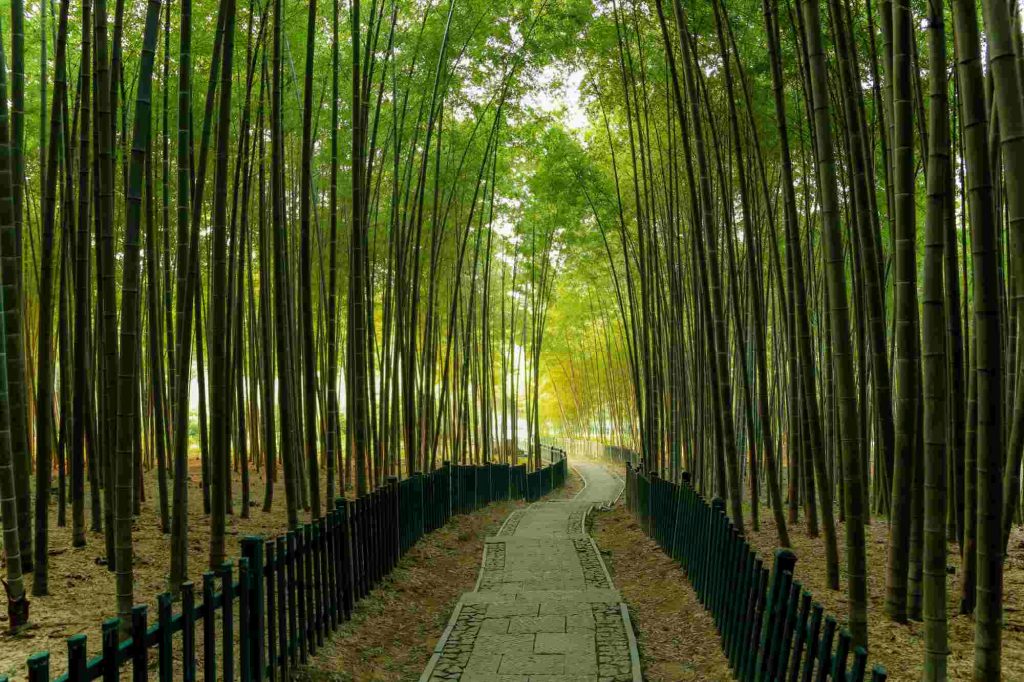
Bottlebrush (Callistemon)
A tough, fast-growing native plant, bottlebrush tolerates most soils and maintains a good shape without much pruning. It attracts birds and bees. Choose a variety that suits your height requirements.
Hibiscus
A popular choice for its colourful flowers and informal, contemporary look, hibiscus is attractive yet tough, fast-growing, and salt-resistant.
Orange Jessamine (Murraya Paniculata)
Orange Jessamine has bright green foliage, growing up to 3m.
Its orange-scented white flowers attract wildlife in spring and autumn.
It suits privacy screening or hedging.
Photinia
Fast-growing, with striking red foliage and white flowers, Photinia suits formal and informal settings and is salt and drought resistant..
Red Robin is a popular variety, growing up to 3m tall.
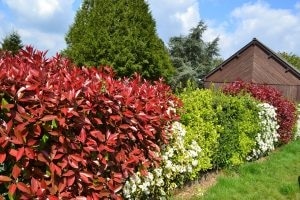
Lilly Pilly (Syzygium)
Lilly Pilly (Syzygium) is a salt and drought-tolerant native, ideal for hedging, screening and topiary. It has glossy, dark green foliage, colourful new growth, flowers and edible berries.
Bush Christmas is a popular variety, growing up to 3m tall.
Viburnum
A traditional favourite — hardy, quick to establish, with attractive flowers and berries.
Fragrant Sweet Viburnum is a popular variety that grows up to 6m tall.
Grevillea
A hardy native, with flower colours ranging from crimson to golden yellow, Grevillea attracts birds and butterflies and makes a great hedge, screen or windbreak.
Robyn Gordon is a popular cultivar, flowering year-round. Some other varieties are close to extinction.
Buxus
Box hedges are a classic option for everything from screening hedges to topiary. They need more water than natives.
Taller varieties can grow 2m high. Slow growth makes them low-maintenance.
African Box is popular in Perth.
Low to Medium Hedges
These are smaller plants, suited to borders and hedges up to 1m tall.
Nandina (dwarf)
Small, manageable shrub, with varied colourful foliage. Stays in good shape without much pruning.
Murraya (dwarf)
Dwarf Orange Jessamine is easily kept to 1m. It has beautiful flowers and fragrance.
Gardenia
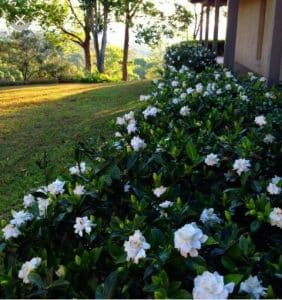
Dwarf Gardenia varieties like Florida make a beautiful perfumed display and stay under 1m.
Gardenias like morning sun, good soil, and plenty of water.
Chinese Star Jasmine
Popular climber with fragrant white flowers that can be clipped into a hedge.
Syzygium
Also known as Lilly Pilly — some varieties grow to 8m, but a few remain under 1m. The most popular is Tiny Trev.
Westringia
A hardy native resembling rosemary, with delicate white or mauve flowers. Some varieties are under 1m.
Other Considerations Before Choosing Hedging Plants in Perth
Before making any final decisions on your hedging plants, consider your unique circumstances and seek expert advice.
For example, the topography of your block means you might be considering a hedge to retain subsiding soil, or you may have particular soil issues which limit planting options.
Before you commit, why not talk to our experienced team at Perth Landscaping Experts to make sure you’ve thought of everything?
How Many Hedging Plants Are Needed?
How many plants you need will depend on why you want the hedge, and what plant you choose.
For example, a hedge planted for security should be dense, so more plants are planted closer together, than for a purely decorative hedge.
A general rule of thumb is 3 plants per metre if the hedge is to be around 1m high.
But here are some examples that show how much variation there can be:
- English Box: up to five plants per metre
- Orange Jessamine: two to three plants per metre
- Viburnum: for tall varieties above 2m, less than one plant per metre
These rules are not hard and fast — if you’re on a budget, you can get away with fewer plants, just by being patient.
Variegated or Regular?
Variegated plants are attractive, but some revert to plain green over time. This is disappointing when they cost more than the plain version — especially if some plants revert and others don’t!
Hedge Repair
Buying a classic plant variety that’s been around a long time will make it easier to replace any plants that don’t flourish — newer varieties can be hard to source.
Hedge Maintenance

It pays to consider hedge maintenance before you plant — some hedges need a lot more TLC than others!
Planting Your New Hedging Plants in Perth
Now you know which hedging plants do best here in Perth, you’ll be keen to make a decision and start planting! But how can you set your hedge up for success?
Start by digging a hole or trench as deep as the plant’s pot. Remove any rocks, adding compost and fertiliser.
Loosen surrounding soil. Tease out roots and gently plant. Water well, adding mulch on top.
It all sounds simple, but if you feel overwhelmed by plant choices, undecided about your garden style, or daunted by the size of the task, why not get some help?
The friendly professionals at Perth Landscaping Experts can help with your entire project – from advising on the ideal plants, to sourcing and installing them!
Call us today on (08) 6263 4646, email us at [email protected] or contact us via the website to find out more!
]]>Here is our guide on all you need to know when it comes to landscaping – even if you are a total beginner.
What is Landscaping?
So let’s get straight to the point and start answering the question “what is landscaping?”
Landscaping refers to the process of modifying the visible features of an area of land, including altering the terrain, planting trees and shrubs, installing structures such as patios and walkways, and creating outdoor living spaces. It can also involve designing and maintaining gardens and other areas of plants, as well as managing the overall appearance and functionality of the outdoor space. Landscaping is a popular way to improve the appearance and value of a property, and it can also provide practical benefits such as providing shade, creating privacy, and controlling erosion.
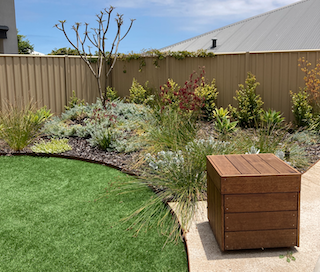
There are many different approaches to landscaping, and the style and design of a landscape will depend on the goals and preferences of the homeowner, as well as the local climate and available resources. Some people may choose to hire a professional landscaper to design and install their landscape, while others may prefer to do the work themselves.
No matter what approach is taken, there are several important considerations to keep in mind when landscaping.
Let’s go more in-depth in this blog to find out more about what landscaping is and its benefits…
Benefits of Landscaping
There are many benefits to landscaping a property, both practical and aesthetic. A well-designed landscape can improve the overall appearance and value of a property, and it can also provide practical benefits such as providing shade, creating privacy, and controlling erosion. Landscaping can also provide an opportunity for outdoor recreation and enjoyment, and it can contribute to the overall health and well-being of the homeowner. Whether you’re a beginner or an experienced landscaper, there are always new things to learn and discover in the world of landscaping.
Some of the many benefits to landscaping a property include:
Improved Appearance
A well-designed and maintained landscape can significantly improve the appearance of a property, making it more attractive and appealing to potential buyers or renters.
Improved Lifestyle
A well-designed landscape can add huge value to the lives of the people who live there! From encouraging the kids to play outside through the use of play spaces and lawn areas, to entertaining areas or relaxed spaces which make spending time at home more enjoyable and fulfilling, your landscape should make your property and outdoors more attractive, livable and lifestyle friendly.
Increased Property Value
Landscaping can also increase the value of a property. A beautiful landscape can make a property more valuable, and it can also increase the resale value of a home.
Practical Benefits
Landscaping can provide practical benefits as well, such as providing shade, creating privacy, and controlling erosion. A landscape may also include outdoor living spaces such as patios and walkways, which can be used for recreation and relaxation.
Improved Health and Well-Being
Landscaping can also have positive effects on the health and well-being of the homeowner. Being surrounded by nature and having access to outdoor spaces can improve mental health and reduce stress, and it can also encourage physical activity.
Environmental Benefits
Landscaping can also have environmental benefits. Planting trees and other vegetation can help to improve air quality and reduce carbon dioxide levels, and it can also provide habitat for wildlife.
Energy Savings
Landscaping can also help to save energy and reduce energy costs. For example, strategically placed trees and shrubs, natural lawn and other green areas can provide shade and an overall cooling effect for your property, which can help to reduce the need for air conditioning in the summer.
Two Key Landscaping Terms
There are two types of landscaping – hardscaping and softscaping.
Hardscaping
When you hear the term ‘hardscaping’ this simply refers to any ‘hard’ landscaping elements such as decking, concrete, paving etc.
Softscaping
You may have guessed based on the above, but ‘softscaping’ refers to the green elements in a landscape; trees, shrubs, flowers and lawn, etc.

Types of Landscaping Services
While it’s possible to do your own landscaping if you have the time, resources and skills, you’ll get much better results, quicker and of a higher, enduring quality if you enlist the help of an expert Landscaping company like us at Perth Landscaping Experts with our professional team of landscapers.
Landscape Design
No landscaping project should begin without a careful, thorough design and planning process. This makes sure that the end result is a space to enjoy, admire and inspire – ensuring that the landscape is well-suited to the local climate and the needs and goals of the homeowner.
A professional local landscape designer has the training and experience to create a landscape that is both visually appealing and functional. They can provide valuable insights and recommendations based on their knowledge of plant materials, design principles, and local conditions.
A key element that often goes wrong in a DIY landscape is the plant choice. A designer with expert plant knowledge will select plants and other elements that are well-suited to the local climate and soil conditions, which can help to reduce maintenance costs and improve the overall health of the landscape.
Landscape Construction
It’s not enough to design the perfect landscape, you need to be able to construct it with quality results. Using poor quality materials, incorrect site preparation, or cutting corners during landscape construction will leave you with many headaches and problems in the long-run, so it’s best to bring in a professional landscape construction company for this part.
An expert Landscaping company should be able to offer all areas of landscape construction services, including:
Lawns
Lawns are an area of grass that is maintained and kept short. They are often used for recreational purposes such as playing sports or lounging, and they can also provide a nice green backdrop for a landscape. There are many different types of grass that can be used for lawns, and the right lawn choice will depend on the local climate and the desired appearance and maintenance requirements.
Trees
Trees are large, woody plants that are often used in landscaping for their aesthetic value and practical benefits. Choose your landscape trees carefully to make sure that their size, type and root systems are right for each location in your landscaping. Trees can provide shade, create privacy, and improve air quality. They can also provide habitat for wildlife and contribute to the overall health of the environment. Trees can be either deciduous or evergreen, and they can be flowering or non-flowering.
Shrubs
Shrubs are often used in landscaping as hedging or screening plants for their compact size and versatility. Shrubs can be used as border plants, as screens, or as standalone specimens, and they can be found in a variety of shapes, sizes, and colours. Like trees, shrubs can provide shade, create privacy, and improve air quality, and they can also provide habitat for wildlife.
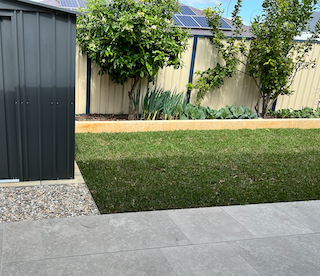
Garden beds
Garden beds are any areas of a landscape that are dedicated to growing plants. These beds can be used to grow a variety of plants, including flowers, vegetables, and herbs. Planting beds can be designed in a variety of shapes and sizes, and they can be raised or ground level.
Water features
Water features are decorative elements in a landscape that incorporate water, such as fountains, ponds, or waterfalls or fountains. Water features can add visual interest to a landscape, and they can also provide a soothing sound and a cool, refreshing environment.
Pathways
Pathways in a landscape that are used for separating areas and providing clear access throughout the landscape. They can be made of a variety of materials, such as concrete, brick, or stone, and they can be straight or winding. Pathways can be used to connect different areas of a landscape, or they can be used as a decorative element. They can also have spaces between them to allow greenery to grow, creating a softer look.
Driveways
Driveways are paved areas that are used for parking or driving vehicles. They can be made of a variety of materials, such as asphalt, concrete, or pavers, and they can be straight or winding. Driveways can be used to provide access to a property or to create an attractive entrance to a home.
Walls
Walls can be used in landscaping for a variety of purposes, such as creating boundaries, providing privacy, or adding visual interest. Walls can be made of a variety of materials, such as stone, brick, or concrete, and they can be found in a variety of styles and sizes. They can also have features such as climbing plants or screens added to soften their look and make them a great backdrop in a landscape.
Fences
Fences can be used in landscaping to create boundaries, provide privacy, or add visual interest. Fences can be made of a variety of materials, such as wood, vinyl, or metal, and they can be found in a variety of styles and sizes. These can also have elements such as screens, climbing frames affixed to them to improve the overall appearance.
Garden Sheds
Garden sheds can be used for storage or as a workspace. They can be made of a variety of materials, such as wood, metal, or plastic, and they can be found in a variety of styles and sizes. Work with your landscape designer to add screening or planting to make them a part of the landscape or hide them so they don’t negatively impact the overall look of the design – but you still get the advantage of additional storage to keep your garden areas tidy.
Decking
There are a myriad of decking options to suit any landscape, from hardwood to composite, or other materials, and they are used for creating additional outdoor living spaces. Decking can be used to create an outdoor living space, such as a patio or a seating area, and it can be found in a variety of styles and sizes.
Styles of Landscaping
Before starting any landscaping, it’s important to decide on the style you want for your property. There are many different types of landscaping, and the style and design of a landscape will depend on the goals and preferences of the homeowner, as well as the local climate and available resources.
If you’re struggling to come up with ideas or make a decision, below are some styles you might consider.
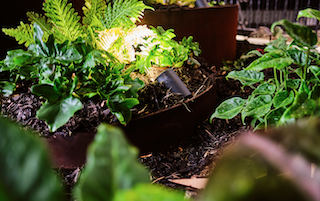
Tropical
Want a lush, tropical landscape to ‘escape’ to? This type of landscaping is characterised by lush, tropical plants and a warm, humid climate. Tropical landscaping design may include elements such as palm trees, exotic flowers, and water features. While trickier to achieve in Perth due to our dry climate and sandy soils, it is still possible with careful planning and soil preparation, along with a great reticulation system and maintenance.
Japanese Garden
The ultimate landscape style for relaxation and a still, zen atmosphere, this type of landscaping is characterised by the use of natural materials such as stone, water, and plants to create a peaceful and serene environment. Japanese garden landscaping may include elements such as waterfalls, koi ponds, and carefully pruned trees and shrubs.
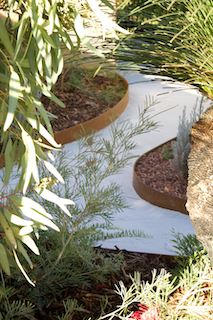
Native
This is our favourite type of landscaping – focusing on using plants that are native to the local area. Perth has a wide range of natives to choose from which are all adapted to the local climate, making it easier to maintain as well as requiring fewer resources to keep healthy. Native landscaping can also help to conserve natural resources and provide habitats for local wildlife. Not to mention – this style of landscape looks amazing!
Desert – or Xeriscape style
This type of landscaping is designed to conserve water, and it is often used in areas with limited water resources – a popular option for us here in Perth. Xeriscape landscaping typically includes drought-resistant plants from the succulent family (such as such as Aizoaceae, Cactaceae, and Crassulaceae), mulch, and efficient irrigation systems. While you might think it would look sparse and boring, these landscapes can look striking while being incredibly easy to maintain!
Formal landscaping
This type of landscaping is characterised by a symmetrical and organised layout, with straight lines and precise shapes. Formal landscaping often includes elements such as formal gardens, topiaries, and carefully manicured lawns. Think Versailles or English mansions – straight from Downton Abbey. This is a very popular modern style but will require a lot of maintenance, so if you aren’t up to it but love the look, make sure you find a great garden maintenance company in Perth to take care of your investment for you.
Informal / Cottage Gardens
Think wildflowers and lush and varied planting. This type of landscaping is more relaxed and natural, with a less formal layout and a focus on native plants and natural materials. Informal landscaping may include elements such as wildflower gardens, natural stone pathways, and meandering streams. These also require expert maintenance to make sure the look stays natural and wild but attractive and true to the design – not overgrown and messy.
These styles are just the tip of the iceberg – the options for landscaping styles are endless. Do plenty of research to find what you like and don’t, then work with a professional landscape designer to customise your look and make the most of your space.
What to Consider Before You Start Landscaping
Along with choosing your landscape design, style and ideal landscaping elements, you need to first think of your goals. Will you be staying in the property forever, or is the landscaping purely to add curb appeal to sell the property? This helps determine the scale of your investment and the complexity of the elements you choose. Also, think about the overall lifestyle requirements. Do you need an entertaining area, pool, play area or relaxation areas? What do you want/need to be able to do outside?
Now that you have a good framework and overall goals, it’s time to think about the details…
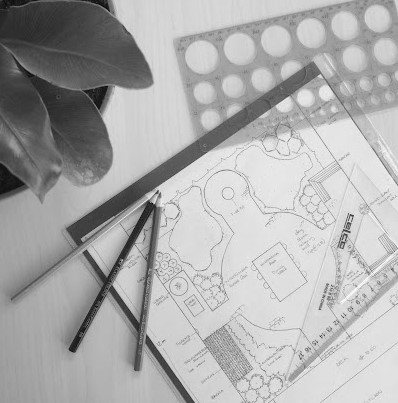
What to Think About When Starting Your Landscaping Project?
- First, it’s important to consider the layout and design of the landscape. This includes determining the overall theme or style of the landscape, as well as deciding on the location of different elements such as plants, trees, and structures. It’s also important to consider the size and scale of the landscape, as well as the surrounding environment and the available sunlight and water resources. Need help with this step? Starting your project with a professional landscape design consultation can get you off to a great start.
- Next, it’s important to choose the right plants and trees for the landscape. This will depend on the local climate and soil conditions, as well as the desired appearance and function of the plants. Some plants may be chosen for their aesthetic value, while others may be chosen for their practical benefits such as providing shade or attracting pollinators. It’s also important to consider the maintenance requirements of different plants, as some may require more care and attention than others.
- In addition to plants, there are many other elements that can be included in a landscape design, such as patios, walkways, and retaining walls. These elements can provide functional benefits such as creating outdoor living spaces or controlling erosion, as well as adding visual interest to the landscape. It’s important to consider the materials and design of these elements, as well as their maintenance requirements and overall cost.
- Once the landscape is designed and installed, it’s important to maintain it to keep it looking its best. This may involve tasks such as watering, pruning, and fertilising plants, as well as controlling pests and weeds. It may also involve regular maintenance of any structures or other elements in the landscape. Whatever you choose to include in your landscape, make sure you think about the maintenance required so that it suits your needs in the long term.
Where to Find Landscaping Ideas
Now that you’ve read our beginners guide explaining what landscaping is, I’m sure you’re eager to get started. So, here are a few tips for where to find good landscaping ideas:
- Observe your friends and families landscaping designs and talk to them about it and the reasons behind what they chose for the style and various features
- Research using magazine, books, television and the internet (you can find some great ideas on Pinterest)
- Get a professional design consultation with a company such as us at Perth Landscaping Experts
- Read landscaping blogs or check out recent design award winners
Ready to Start Your Landscaping Project?
If all of the above has given you some great ideas but also made the idea of your project seem quite overwhelming – don’t hesitate to get in touch with us. We can take you from design to the finished construction and make it easy to build the landscape of your dreams.
Call our friendly team today on (08) 6263 4646 or contact us here to begin.
]]>Maybe you’re gazing sadly at your existing lawn, wishing it was green and springy like it used to be, instead of sparse and brown!
Or maybe you are planning a new build or renovation, and want to get everything right the first time.
Let’s face it, most of us don’t know much about grass — our lawn is something that is just there, doing its job, keeping the backyard from becoming a dustbowl, or making the front yard look presentable.
We often inherit someone else’s choice of lawn, and don’t even necessarily know what type of grass we have!
If you are planning to establish a new lawn, the type of grass you choose will impact your landscape, and even lifestyle, in the future. It will determine how often you need to mow, and the amount of maintenance required; like how much water and fertiliser are needed.
Choosing a grass type that doesn’t suit your conditions may mean your lawn dies in winter or struggles in summer.
Your home’s value can also be enhanced by a beautiful lawn, while a scruffy lawn can detract from ‘street appeal’.
So whether you are building, revamping, or starting over because your old lawn is beyond repair, do your homework before you commit. It might help you avoid a lifetime of being a slave to your lawn!
- Lawn Grass Types in Australia
- What to Consider When Choosing Types of Grass
- What to Consider When Choosing Types of Grass for Your Lawn
- Grass Types in Western Australia
- Buffalo grasses – ‘Palmetto’ and ‘Sir Walter’
- Zoysia grasses – ‘Empire’, ‘Sir Grange” and ‘Platinum’
- Couch Grasses – ‘Bermuda’ and ‘Wintergreen’
- The right grass for you – make the choice with Perth Landscaping Experts
Lawn Grass Types in Australia
There are a variety of lawn grass types available in Australia, but not all of them are suited to Perth’s unique climate and sandy soil.
Grass types in Australia are often those that have succeeded in the US or Asia, suited to either temperate or tropical climate zones.
Western Australia includes several climate zones. Perth homeowners may find success with both warm and cold season grass types.
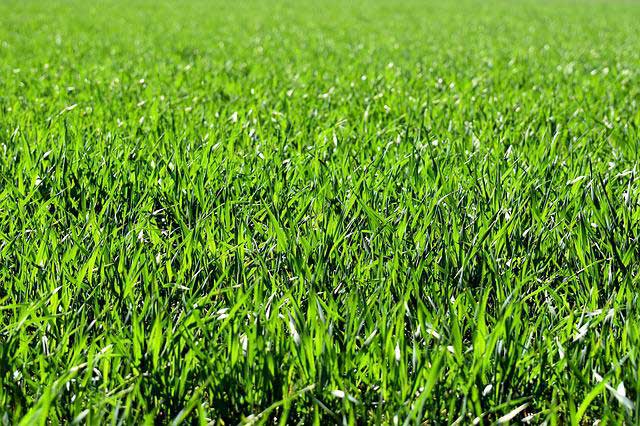
What to Consider When Choosing Types of Grass
Before choosing types of grass to plant or deciding to lay turf, consider what you want from your lawn, and what you are willing to do.
- Do you just need a tough, serviceable lawn that will be low maintenance, and safe for kids to play on?
- Or do you want a truly beautiful lawn to complement an upmarket home – soft underfoot, and brilliant green in colour.
- Is your budget strict? Or will you pay whatever is needed to get the right result?
- What about the time and effort you are willing to put in to establish and maintain a new lawn?
To get the result you want, you need a plan and a realistic idea of what’s involved.
Deciding whether to lay turf or grow a new lawn from seed or runners
The best lawn grass choice can transform your garden, adding value to your property and creating a lush green environment. Grass can even help to cool your garden, and make the garden safer and more enjoyable for you, your children and your pets.
So what is involved in choosing lawn grass?
Well, before you choose your grass type and method of establishing a new lawn, it pays to consider:
- your soil
- the ‘micro climate’
- water availability
- how much sun the area gets
- how much time you can spend establishing and maintaining your lawn
- your budget.
The pros and cons of growing grass from seed (or runners)
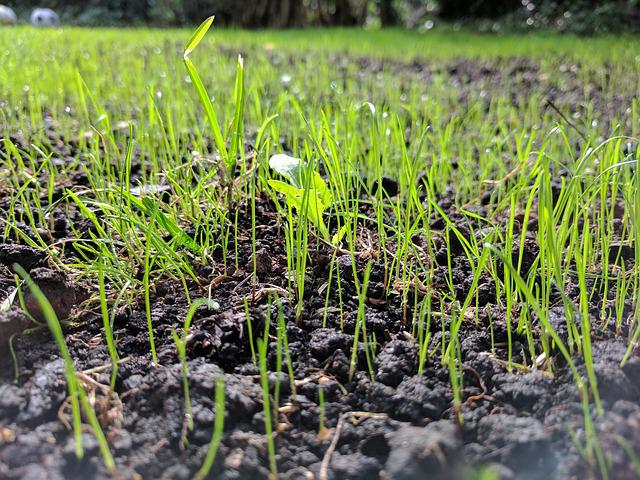
PROS of growing grass from seed:
- affordability
- no great skill, strength or stamina is needed
- wide choice of grass types
- lawn seeds can be a blend of grasses, for a hardier lawn.
Some grasses won’t grow from seed, only from runners.
CONS of growing grass from seed (or runners):
- seeded lawns may need reseeding several times (birds can devour seed, rain can wash it away)
- weeds invade seeded and runner lawns in the early stages
- it will be months before the lawn is usable
- the season for establishing these lawns is limited
- grass can die if conditions aren’t right.
- a lot of watering is needed for the first few months – if you work long hours it may not be practical to grow grass from scratch.
The pros and cons of laying turf
The PROS of turf include that it:
- is the quickest, easiest way to establish a new lawn
- gives a high quality, consistent look
- is usable within weeks
- will always be a grass suited to local conditions.
The CONS of turf include:
- it is expensive, especially for large areas
- there are extra costs (or heavy work) in preparing the site and laying turf
- the choice of grass types is slightly more limited than with seed.
Talk to a landscaper with expertise in lawns (like Perth Landscaping experts!) for advice before deciding on grass types.
What to Consider When Choosing Types of Grass for Your Lawn
Growing conditions
First, consider your soil type. For sandy soil, choose grass that likes to be well-drained.
Think about your ‘microclimate’ – salt air, frost, shallow soil, overshadowing, urban heat and drainage can all be factors.
Another key condition is hours of sunlight. Is your lawn mainly in shade or sun? Certain lawn grasses do well in shaded areas, others die back if there isn’t enough sun.
If an area is too heavily shaded, the lawn may not be viable. You might have to consider paving, ground cover or artificial lawn.
Again it pays to consult an expert landscaper, who can assess the growing conditions and advise on options.
Lifestyle and maintenance time and costs
Be realistic about your lifestyle and how much time you can devote to lawn care, both while establishing your lawn, and later.
Growing grass from runners, or planting a seed lawn requires significant time and effort. You will need to water, fertilise and weed during the establishment period and long term.
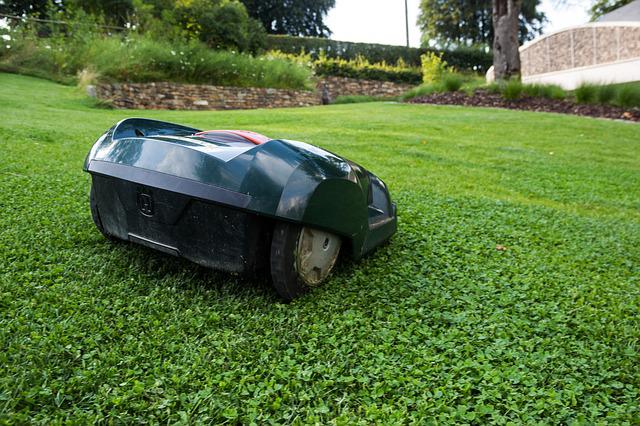
Think about how often you want to mow (or pay for mowing) in the long term. Some grasses require much more frequent mowing than others. For some, it is recommended you use a cylinder mower, another big outlay.
Water/fertiliser requirements and sustainability
Is the cost of water important to you? Do you value sustainability?
Some grass types survive without a problem being watered just twice weekly in summer, and some need little or no fertiliser. Others are much thirstier and hungrier.
Fertiliser and water are ongoing costs, particularly if scheme water is used, and costs will only increase in the future. Bear this in mind when selecting grass.
NOTE: Twice weekly watering is the maximum allowed with scheme water in Perth, using an automated system. Bore owners can water three times a week, but this may soon change to twice weekly.
Watering exemptions are possible when installing new lawns — you can apply via the Water Corporation.
Budget
As already discussed, decisions often end up being budget-driven.
If you can afford it, instant turf gives ‘instant gratification, with minimal up-front effort.
Fast-growing grasses are usually the most economical.
To get the best result you may need to install an automated irrigation system if you don’t already have one. If you travel for work or your schedule allows little time for watering, this is a must.
Talk to a landscaper about which systems work best in Perth conditions, and get some quotes.
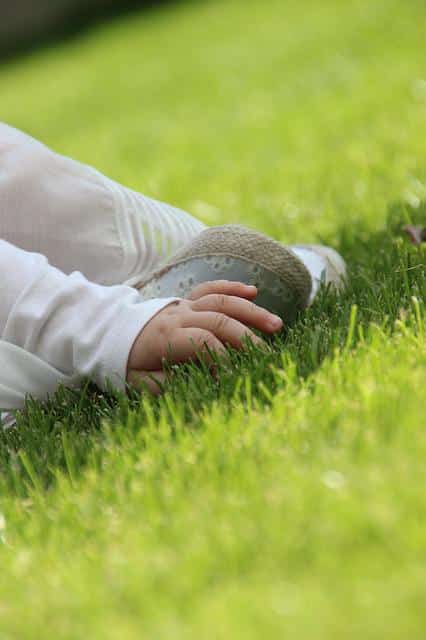
Aesthetics, feel and the ‘sneeze factor’
If the aesthetics of your home are a primary consideration, ask a landscaper to point you to some lawns they have installed. Check them out to see what appeals. Consider the colour and feel of the grass.
If children will be playing on grass (or you like to exercise on the lawn) softer varieties are most appealing.
If anyone has allergies, consider low-seeding grass types.
Area
The larger your proposed lawn area is, the more strategic it pays to be.
For large areas, costs can be substantial. Buying turf, runners or seed, watering costs while establishing grass, and long-term water, fertiliser and mowing costs, all add up.
There are some ‘tricks of the trade’ that may help – ask a landscaper for advice.
Grass Types in Western Australia
A variety of lawn grass types are used in Western Australia.
We have already discussed problems that can arise if you plant grass that doesn’t suit your conditions, so it’s important to choose the right grass for your garden and lifestyle.
Here we share our knowledge of ten of the best types of grass for lawns
We explain which conditions suit each of them, and their pros and cons, to help you make an informed choice.
Buffalo grasses – ‘Palmetto’ and ‘Sir Walter’
1. Palmetto Buffalo (stenotaphrum secundatum)
Palmetto Buffalo is one of the most popular grass types for Perth lawns.
Its benefits include:
- soft texture
- vivid green colour almost year-round
- low thatch (helps to stop it drying out)
- drought tolerance — it survives the full glare of our summer sun
- no rhizomes or underground roots, so it doesn’t invade pavers and garden beds
- hard-wearing, suits high-traffic areas
- produces little seed, so unlikely to trigger allergies
- needs less mowing than most buffalo grasses.
Palmetto’s CONS include that it:
- is not cheap
- loses colour in winter if not in full sun
- is slow to recover if damaged.
RECOMMENDED FOR: gardens where moderate watering and maintenance are desirable, families with children, and locations with good winter sun.
2. Sir Walter Buffalo (stenotaphrum secundatum)
Sir Walter is another very popular soft buffalo grass, very similar to Palmetto.
Key differences include these PROS. Sir Walter:
- keeps its winter colour in partial shade
- grows actively in winter, improving appearance
- has an even greater tolerance for wear and tear than Palmetto
- has slightly better drought tolerance.
CONS of Sir Walter include that it:
- is not as low-thatch as Palmetto
- produces more seed
- is faster growing so
- needs mowing more often.
For more information, check out this independent research carried out in WA.
RECOMMENDED FOR gardens where moderate watering and maintenance are desirable, families with children, locations with less winter sun.
3. Kikuyu (cenchrus clandestinus)
Kikuyu is another popular grass type. Its PROS are being:
- inexpensive
- sun tolerant, drought-resistant
- suits sandy soils
- fast-growing, covers bare areas quickly
- hard to damage, fast to recover from damage
- self-sufficient, no expensive fertilisers needed
- attractive in winter
- resistant to pests and diseases
- not highly allergenic.
Kikuyu does have some CONS. It:
- invades garden beds
- needs 5-6 hours of sun per day
- requires weekly mowing in summer
- is almost impossible to eradicate, resisting most herbicides
- forms a dense thatch – insects and fungus may thrive, depleting soil nutrients.
RECOMMENDED FOR: large gardens, ovals, parks, or any project with a tight budget.
Zoysia grasses – ‘Empire’, ‘Sir Grange” and ‘Platinum’
4. Zoysia Empire (Zoysia Japonica)
Zoysia Empire is a popular warm-weather grass. Its PROS include being:
- attractive
- soft underfoot
- shade tolerant for up to 40% of the day
- extremely drought resistant
- non-invasive and pest resistant
- low maintenance, not needing frequent mowing.
CONS include Zoysia being:
- relatively expensive
- not frost tolerant
- slow to establish, especially if growing conditions are not quite right
- slow to recover after damage.
RECOMMENDED FOR: Small to medium gardens, areas with light shade and families with children.
5. Sir Grange Zoysia (Zoysia Japonica)
PROS of Sir Grange Zoysia are that it:
- needs only 3-4 hours of sunlight
- is low maintenance, less mowing, pesticide and fertiliser than most grass
- is highly drought tolerant
- is fine, and soft
- recovers well if damaged.
CONS of this grass include:
- expense
- it is thick, so heavy work to mow, and can be damaged if cut wrongly
- it’s slow to recover if damaged.
RECOMMENDED FOR: Small to medium gardens, or larger spaces where budget permits and gardens in high-density areas where overshadowing is an issue.
6. Platinum Zoysia (Zoysia Japonica)
Platinum Zoysia’s PROS include that it:
- thrives in extreme heat
- requires less watering than most lawns – it rolls its leaves to conserve water
- is dense, soft to touch and dark green in colour
- is non-invasive of garden beds
- can be mown with a rotary mower (many fine leaf types of grass need mowing with a cylinder mower).
Platinum Zoysia’s CONS include:
- expense
- it performs less well in shade and may go brown in winter
- slow-spreading.
7. Fescue (Schedonorus arundinaceus)
Fescue is another popular grass, best suited to a cool climate but used in Perth.
Its PROS include that it:
- is hardy, grows well in poor soil
- does not need frequent mowing
- doesn’t die back in winter
- has deep roots, survives without irrigation if rainfall is regular
- germinates quickly.
Fescue’s main CONS include that it is:
- susceptible to pests and diseases in wet conditions
- coarse and bristly.
RECOMMENDED FOR: Cool areas with good rainfall and well-drained soil.
Couch Grasses – ‘Bermuda’ and ‘Wintergreen’
8. Bermuda Couch (Elymus repens)
Bermuda Couch is another popular grass variety in Perth. Its PROS include being that it is:
- hardy, with a strong root system
- drought resistant yet survives being waterlogged
- tolerant of sandy, saline, acidic, alkaline, and clay soils
- fast to establish
- traffic tolerant
- quick to recover if damaged.
Some CONS of Bermuda Couch include that it is:
- not shade-tolerant
- invasive, creeping into garden beds
- less soft than some couch grasses.
RECOMMENDED FOR: family lawns with high wear and tear, climates with extreme heat and wet.
9. Wintergreen Couch (Elymus repens)
‘Wintergreen’ Couch, also called Nullarbor Couch, is very popular in Perth. Its PROS include being:
- tough, hard wearing
- tolerant of winter cold and strong sun
- soft, fine, a good colour
- relatively cheap
- environmentally friendly.
CONS of this grass include that it:
- loses colour in winter if not well-maintained
- invades paving, garden beds
- can’t be eradicated using general herbicides
- is expensive to maintain.
RECOMMENDED FOR: Suburban homes with low water use and/or a tight budget, golf courses, tennis courts, and wherever close mowing is required.
`10. Elite Backyard Blend
Elite Backyard Blend is a popular seed mix.
It contains Sports Turf Ryegrass (Lolium perenne) and Creeping Red Fescue (Festuca rubra).
Its PROS include:
- shade tolerance
- drought resistance
- summer-active and winter-active seed types
- soft texture, good colour
- reasonably hard wearing
- resilient in winter
CONS include:
- not coping well with harsh summers
- needing plenty of water in summer to stay green.
RECOMMENDED FOR: Suburban homes with high traffic, shady gardens, and frost-prone areas. It suits regions where conditions can be hot and cold at different times.
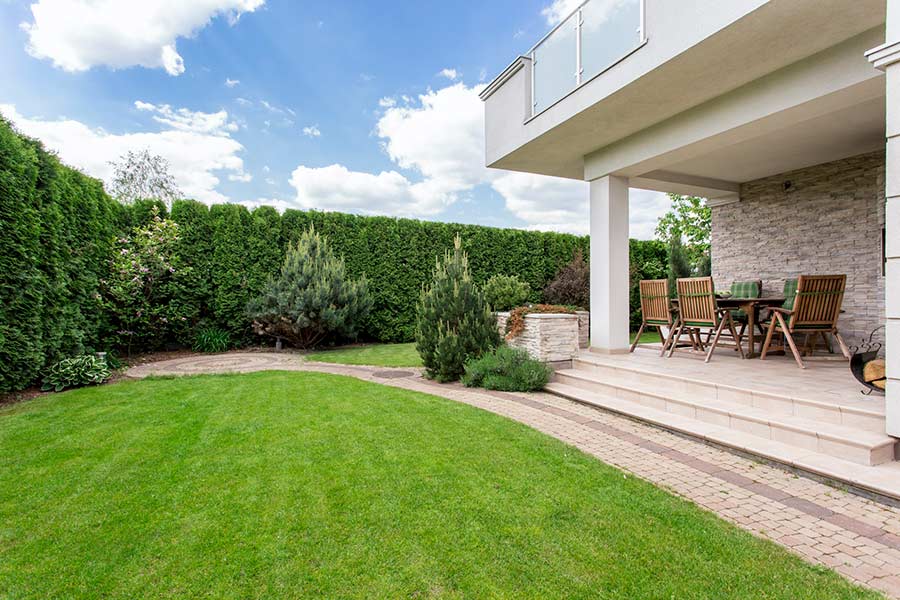
Best ‘All Rounder’ Lawn Grass Type
Are you still struggling to choose the right grass for your lawn?
We’d love to be able to recommend the best all-rounder grass and solve your dilemma, but it just isn’t quite that simple.
There are certainly some very popular grasses, but as we’ve explained, the best results come from analysing your growing conditions, taking into account your budget and the time you can realistically spend on maintenance.
The best thing to do if you’re unsure which types of grass to plant is to contact the experts at Perth Landscaping. We’ll look at your site, listen to your needs, and help choose the best lawn grass for you. We can even help you install it so that you get that perfect finish. Our sister company Perth Gardening Experts also have some top lawn care tips which will help too.
In the long term, getting it right the first time could save you a lot of time, money and frustration!
The right grass for you – make the choice with Perth Landscaping Experts
So how will you choose the right grass to create your own personal oasis of green?
We’d love to help with your choice. Give us a call today on (08) 6263 4646 .
]]>If lately, you’ve spent more time than usual at home, you may have spent some of that time gazing at your backyard. So you may know by now what you like, and what you’d love to see transformed…
Perhaps there’s a particular problem that needs solving? Perhaps it’s an ugly dead lawn, or too few shady spaces to relax.
Sometimes a backyard just doesn’t look good. You may be itching to show your creativity by creating a whole new aesthetic.
You may want to make your backyard more practical to entertain more outdoors — or maybe you just want to make your backyard quieter or more private.
If you’re planning a lifestyle change like retirement, that can also inspire change. You may want to make your backyard easier to manage, or to set it up to produce food, now that you will have more time for gardening.
Many people also want to make their gardens more sustainable and waterwise, both to reduce their impact on the environment, and to cut watering costs.
Whether you want a change for lifestyle reasons, or you’re getting ready to sell/rent your property, we can give you practical backyard landscaping ideas that can help take your garden to the next level!
Best Landscaping Ideas for Backyards
Backyard landscaping doesn’t have to be rocket science, but it can feel overwhelming when you’ve never done it before! If this is your first landscaping project, you’ll need to do some research into backyard landscaping ideas.
To get the best results we recommend you also get some expert advice. There are many aspects of landscape design to consider — layout, what to plant, special features, materials, equipment and the budget.
It can be hard for a first-time landscaper to know how to approach all this! It may seem best to just do one small project at a time, but without a plan, you won’t get a unified looking result at the end. Some ideas also just don’t work well in some locations, or are tricky to execute without professional help or specialised equipment.
Inexperienced home landscapers often approach landscape design purely in terms of aesthetics; choosing a picture from a magazine, and faithfully replicating it. Design ideas are certainly important, and a magazine can be a great starting point, but without the right knowledge of plants, soil types and the movements of the sun, blindly copying a design may lead to problems down the track.
For example, that beautiful tree in the magazine may have a huge root system that will lift your pavers, or wreck your plumbing. Bedding plants shown in that inspiring photo may need more sun than your garden has or a different soil type.
NOTE: Plants in magazine photoshoots are always photogenic but may not be hardy or easy to care for. Even turf needs to be carefully selected, as not all grasses survive year-round in every backyard.
An expert can help you get the look you want, or solve that nagging problem while staying within your budget. Often they can help you choose low maintenance plants that give much the same effect as those pictured in magazines.
For a sustainable result, it’s important to choose a design that suits local conditions, your personal taste, and how much time you can spend gardening.
With expert help you can achieve a look you love, using plants that will flourish in your soil and climate.
Beginning to Plan Your Ideal Backyard
Considerations at the beginning of your backyard landscaping planning process include:
Key outcomes: Know what you want to achieve, whether it is to beautify, become sustainable, improve property values, or to eat ‘healthy and homegrown’.
Overall theme/aesthetics: Consider what style of garden will suit your house and lifestyle. What would you enjoy looking out at?
Relaxation and recreation: Backyards are for living, so prioritise space for what you love, whether it’s yoga, exercise, meditation, reading or outdoor play with kids.
Maintenance: Think about how much time you want to spend gardening. If you travel a lot or plan to rent the property out, keep your backyard low maintenance. Look for long-lived plants, and use materials that won’t rot or need repainting.
Privacy: Do you need to block out the view of an ugly shed or create an acoustic barrier?
Safety: If you have (or will have) young children, fences are a must-have. Avoid water features and poisonous plants like oleander and lantana.
Storage: Sheds are never glamorous, but with planning, they need not be an eyesore.
Expertise and Equipment: Once you have an idea of what you want to achieve, consider which parts of the project you can manage yourself, and what expert help you might need.
Budget: You will need a budget to work to. Either your budget decides what you can do, or what you want to do decides what you will spend. Those two don’t often meet in the middle so it’s important to decide this upfront! Bear in mind that you are adding value to your property in the long run.
Express Your Creativity With These Backyard Landscaping Ideas
Landscape design is about creating gardens that are both beautiful and functional.
Many people find it helps to have a theme, choosing structures and plants to work in harmony.
Popular themes for backyard landscaping ideas in Western Australia include:
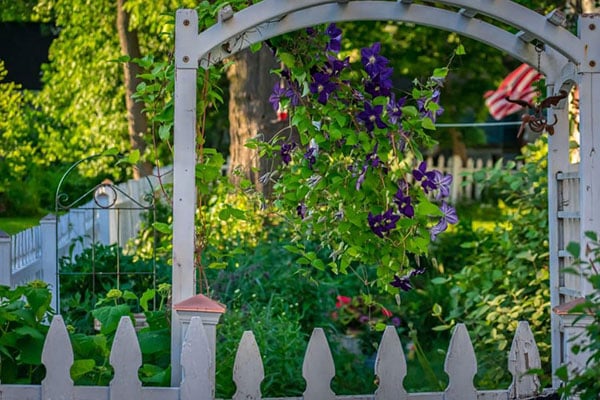
1. Cottage garden
This rambling style looks a little chaotic but is actually carefully planned, using harmonious colours and contrasting heights and textures. ‘Wildflowers’ (exotic and native) are a popular inclusion, self-seeding and returning each year.
Cottage gardens require less maintenance than formal gardens. They complement period and rustic homes, often using traditional structural elements like arches, garden seats, trellises, crazy paving, ponds and gazebos.
2. Formal garden
By contrast, a classic, formal garden design is usually symmetrical and very well maintained. Closely mown lawns, clipped hedges, rows of cypress trees, standard roses, geometric beds and topiary plants in tubs are all typical. Greenery dominates with flowering plants often limited to a single-colour theme like all white.
Variations of the formal style include English, Italian and French-style gardens. Each of these can complement any generously scaled home, but ideally, garden-style is matched to architectural style. For example, an Italian formal garden for a Tuscan-style villa, or an English formal garden for a Georgian mansion-style property.
Structural elements are important, including statues, columns, stone seats, walkways, retaining walls, edged beds and fountains.
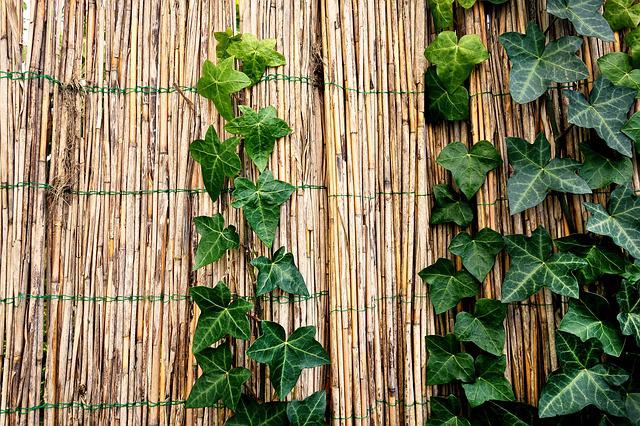
3. Oriental garden
This style creates a feeling of serenity inspired by garden styles from Asia.
Bali-style gardens are popular in Perth, planted with tropical plants like palms, ferns, monstera, ginger, bougainvillaea, canna and frangipani. Green is the dominant colour, creating a tranquil feeling.
Japanese style gardens are less tropical and include plants like azaleas, rhododendrons, Japanese maple, privet and the iconic cherry tree.
Bamboo and water plants can be used in both styles.
Structural and decorative elements like winding stone paths, oriental statues, and large urns are typical. A water feature is usually used to create a tranquil atmosphere.
This style is versatile and can suit modern or older homes, but may not suit young families as lawns are not normally a feature.
4. Waterwise garden
This theme relies on the garden being adapted to the terrain and climate. Drought resistant plants are used in hot spots, ground covers can replace thirsty lawns, and water-loving plants are planted in boggy spots.
Native shrubs and grasses, cacti, drought-tolerant perennials and succulents are all typical.
This style can suit any type of architecture but particularly suits a sustainable home.
Structural elements are often practical – rainwater tanks and greywater systems.
Natural-looking items like rough-hewn benches, small ponds to attract the birds, sleepers, stone slabs and pebbles also feature.
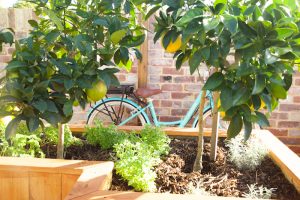
5. Edible garden
Traditional Aussie gardens in Perth were once known for roses and neat flower beds, while the Italian neighbours grew fruit and olive trees, grapevines and vegetables.
Nowadays we all grow herbs, and many of us grow fruit and seasonal vegetables. Bush tucker plants are also making an appearance.
An edible garden can be incorporated into any garden, but there are some gardeners who now try to make almost their entire garden edible. They may include flowers, but it is possible to choose so that even they can be eaten – nasturtiums, zinnia, hosta and chrysanthemums for example.
Like Waterwise gardens, edible gardens can suit any home. They often include plantings to attract butterflies and bees, so important as pollinators when growing fruit trees.
Structural elements tend to be practical – for example raised beds to make weeding easier, rainwater tanks, compost heaps and trellises to raise vines.
6. Mediterranean garden
This backyard landscaping idea theme suits Perth’s coastal Mediterranean climate.
Plants used include olive trees, citrus trees, grapevines, tomatoes, capsicum, and herbs like rosemary, oregano and basil. Lavender, bougainvillaea and geraniums add a decorative element.
Mediterranean gardens are similar to edible gardens, but emphasise aesthetics. It suits beachside suburbs, as the plants withstand hot, salty, and windy conditions.
Structural elements can include stone seats, walkways, retaining walls, tubs, urns, fountains and pergolas.
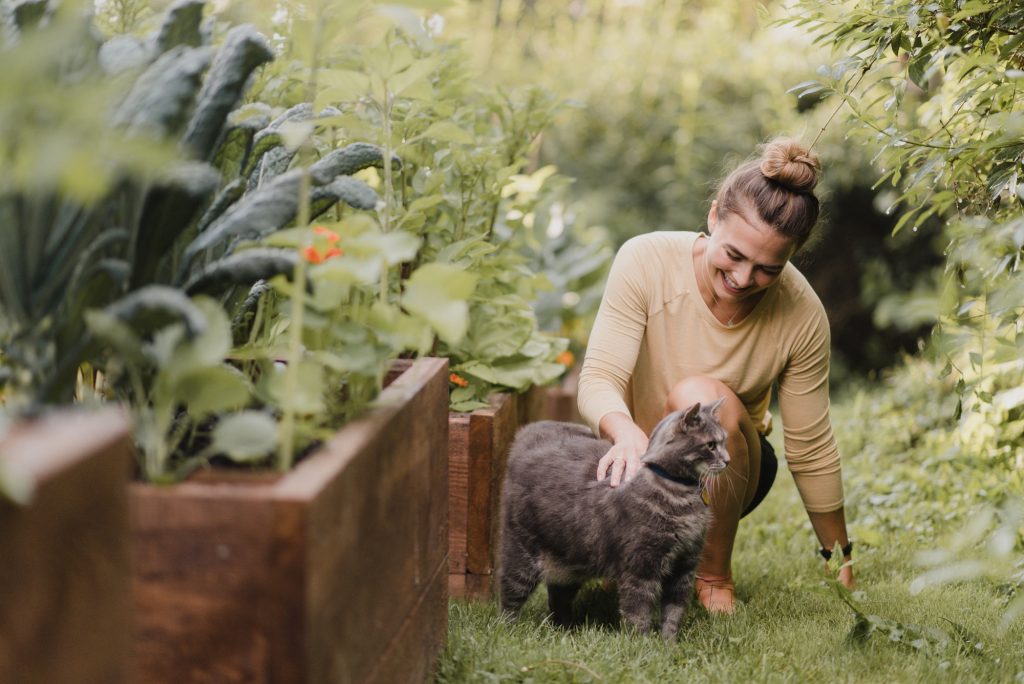
7. Family and pet-friendly garden
This popular garden style includes hardy lawns for pets and play, low-maintenance plants, entertaining and cooking areas, and may incorporate a veggie garden.
It suits any family home and a functional attractive result can be achieved on a moderate budget (or you can go all out!)
Structural elements include play equipment, pools and spas, gazebos, pergolas, decks, dining areas, barbecue/outdoor kitchen areas, and secure fencing.
Plants to Fit Your Backyard’s Theme and Conditions
Choose plants to fit your backyard’s theme and your growing conditions. Here are some more backyard landscaping ideas to make sure your plants work with the environment you have.
1. Consider your solar aspect
Plot areas of shade, part-shade, and full sun so you can plant what will thrive in each area.
2. Choose plants that suit your soil type/conditions
Choosing the right plants for your garden’s environment is crucial for success.
Your soil is likely to be sandy, so choose suitable plants, or be prepared to build the soil up with compost. Some plants actually help improve soil, so seek these out.
3. Think about watering
Do you have a bore or water recycling system?
If not, drought-tolerant plants are most practical.
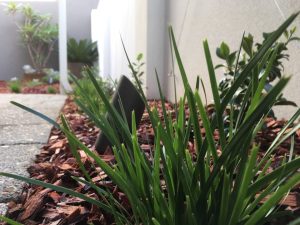
4. What is your space like?
How large will plants be when fully mature?
Will the plants you like fill the space without overcrowding it?
5. Choose plants that will work in harmony
Do the plants work together to create a cohesive look that suits your theme, with a consistent colour scheme?
Pastels work well for a cottage garden, ‘hot’ colours for a tropical garden, and white flowers in a predominantly green garden.
6. Consider contrast and balance
A variety of plant heights, with taller plants at the back, makes a garden more interesting.
Contrasting textures like ferns, mosses, groundcovers and grasses add variety. Symmetry isn’t essential unless the garden is formal, but balancing the scale of different areas is pleasing to the eye.
7. Group plants together
Plan for large groupings of plants — having just one or two of a plant may not look as good.
8. Study the seasons
Include some plants that look good year-round and some that flourish in each season.
Think about whether trees are deciduous – this can be good to let the sun reach a winter lawn, or less good if you are trying to mask an eyesore!
9. Breathe easier with air-purifying plants
All plants help to reduce air pollution, but some are more effective than others.
If you live beside a busy road, chrysanthemums, bamboo, philodendron and silver birch can help.
10. Backyard landscaping ideas to stimulate the senses
A garden should cater for all the senses. As well as aesthetics, think about scent, sound and touch.
Soft grass and aromatic groundcovers feel and smell wonderful underfoot. Perfumed plants like gardenia and jasmine make a garden smell amazing at night.
Flowering natives attract birds — their songs add to your backyard experience. You can also add a wind chime for musical sounds.
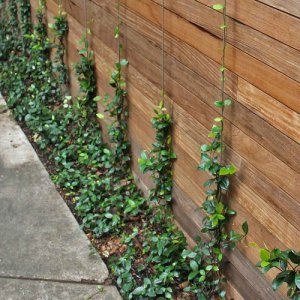
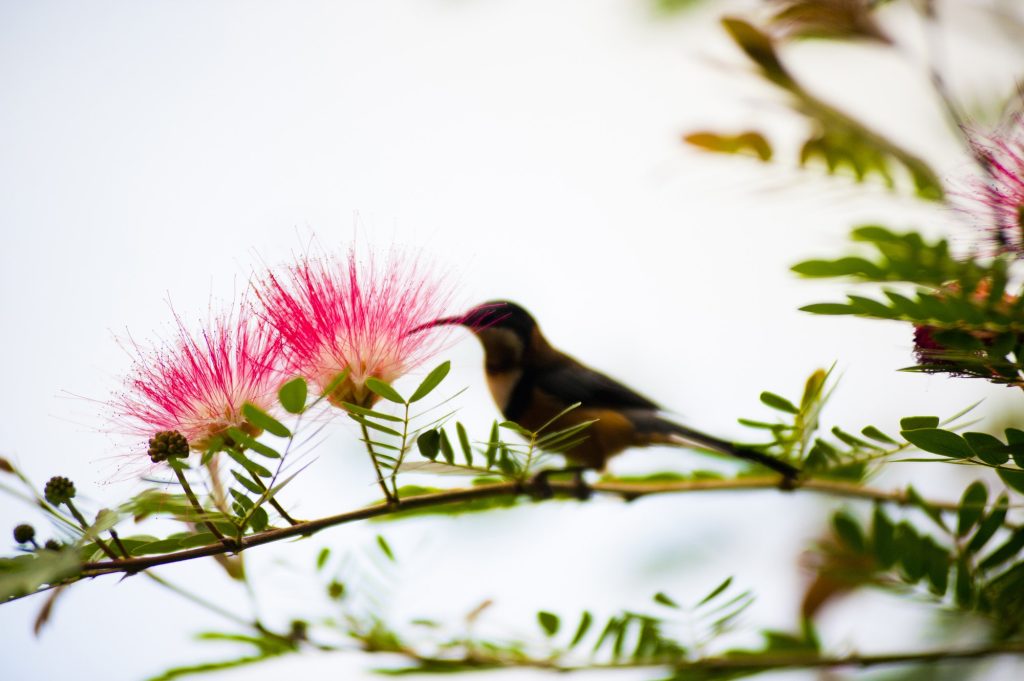
Structural Features to Incorporate in Backyard Landscaping Ideas
1. Statues, benches and urns
A moveable statement piece like a statue, bench, or urn can lift a garden to the next level.
It is a way of expressing your personal creativity, so depending on the scale of your garden, it may be worth splashing out on one striking piece.
We all have different tastes and budgets, so there’s no right or wrong when it comes to statues.
Even garden gnomes have their place, having gone from ‘tacky’ to being considered ‘retro-charming’ in recent years!
Even ladders, wheelbarrows, old stoves and bathtubs can look great in the right spot.
Large urns planted with striking ornamental plants to suit your theme can be stunning – topiary, standards, cumquat or bird of paradise all work well.
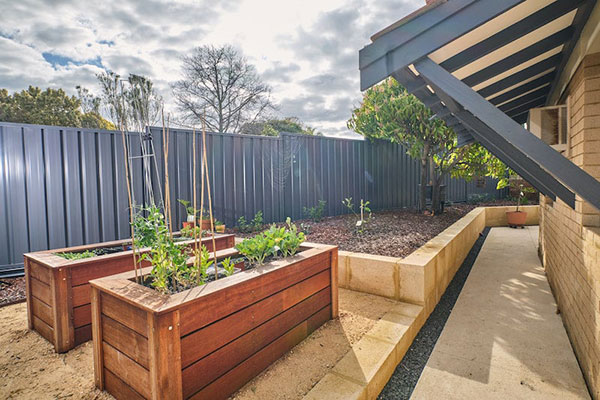
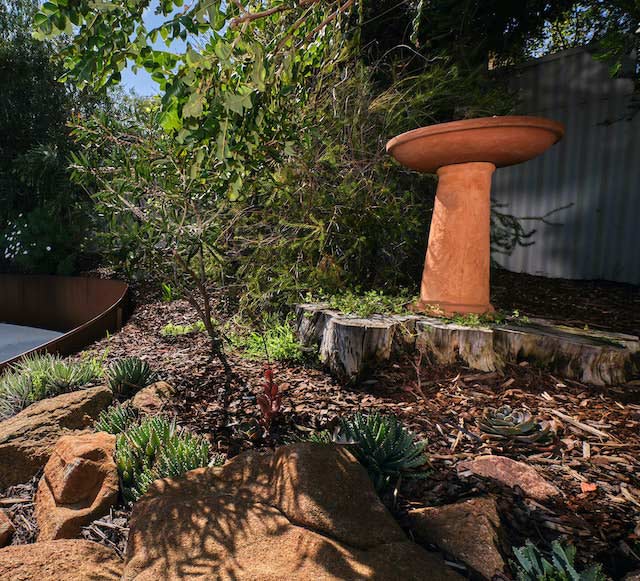
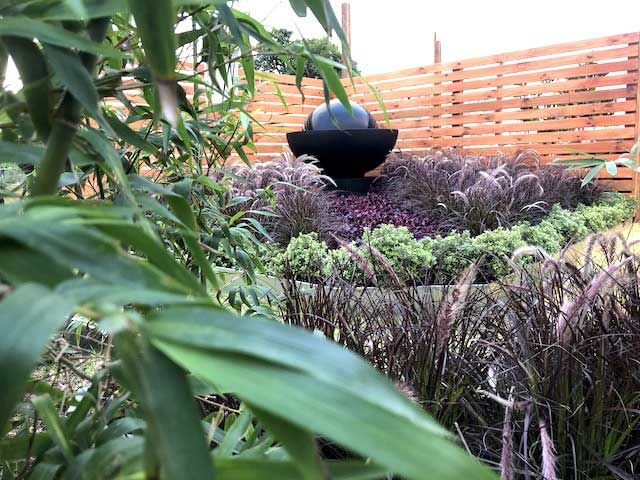
2. Add some outdoor furniture
A well-placed bench or stone table can look beautiful and has practical uses – they can be great for entertaining friends and family outdoors during the warmer months.
Adding flexible, functional seating is always a good idea.
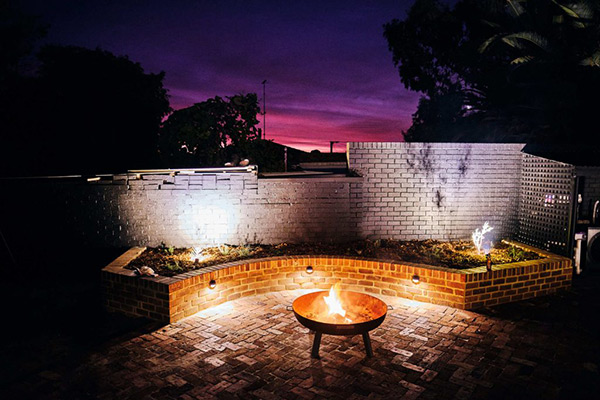
3. Fire pits and outdoor ovens
A fire pit can be a central focus in an entertaining area and is becoming a must-have feature in Perth landscape designs – especially if you like to entertain during colder times of the year.
An outdoor oven is a practical and perfect addition for Perth homeowners who love to entertain. Perhaps your pizza can become the envy of the neighbourhood….
4. Archways, walkways and pergolas
Built structures like archways, walkways and pergolas can also transform your garden and provide shade. Cover them with scented flowering creepers like wisteria, or edible ornamental climbers like grapes or passionfruit.
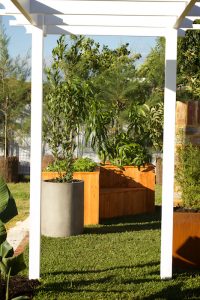
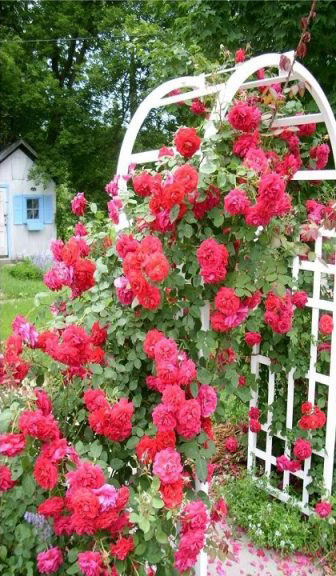
5. Add tranquillity with a water feature
If you can, include a water feature. it will add a tranquil element and help attract birds, frogs and other wildlife.
Fountains, birdbaths, natural ponds or even small streams can add a feeling of being secluded away in nature.
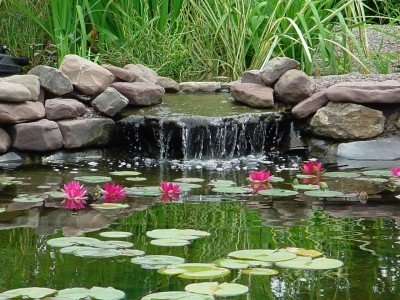
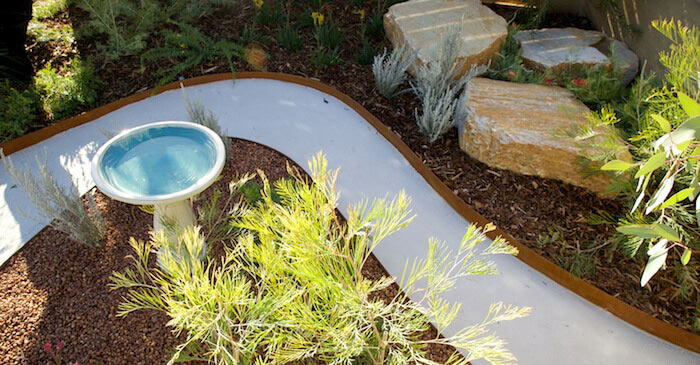
6. Harmonise with your home’s architecture, and keep to a theme
As a rule of thumb, try to choose items that harmonise with your garden theme. If you’ve designed your garden in keeping with your home’s architectural style, the whole effect will be harmonious.
Remember, a buddha statue may look beautiful in a tranquil pond, but mismatched in your rose bed. A classic Italian statue is perfect in a formal European garden, but out of place in a native garden.
Place your structural centrepiece to draw the eye to the line of a path or wall, and add outdoor lighting to highlight a night-time garden.
Low-hassle, low-maintenance backyard landscaping
Creating a low-maintenance backyard is a huge topic, but here are a few key points to consider as you plan and research landscaping ideas for backyards.
1. Reduce the need for backyard mowing
If you hate mowing or have mobility/health issues that make it difficult, consider replacing the lawn with groundcover, decking, artificial lawn, pebbles or paving.
2. Save time on backyard watering
Watering can be time consuming, and if you struggle with gardening it may feel like a chore.
You might find it easier to install an automated watering system to avoid hand-watering.
3. Choose low-maintenance plants
To reduce your backyard gardening workload, choose hardy plants like succulents, cacti and slow-growing natives that don’t need to be pruned, watered or regularly replaced.
4. Backyard weeding begone!
Weeding is the bane of many gardeners’ lives.
Install weed mat and mulch for less weeding!
5. Choose hardy backyard materials
When you’re building outdoor structures in your backyard, use materials that don’t rot or need repainting. This will reduce your future workload.
Improve property values with backyard landscaping
Most of us garden to improve the space where we relax at home.
But sometimes we spruce up our gardens purely to prepare our home for sale. After all, experts claim that landscaping can add up to 28% to a property’s value.
Here are some additional ideas experts suggest to improve saleability.
1. Keep up lawn/garden bed care
To maximise your property’s value, keep up your garden care as often as possible. Remember to:
- mow and edge lawns
- replace scruffy lawn areas with turf / artificial lawn
- weed garden beds regularly
- mulch with pine bark (not straw) for best results
- replace straggly plants with fresh annuals
- prune branches, particularly near windows
- sandblast driveways/pavers, and remove moss/weeds.
2. Add plants strategically
Consider these other landscaping tips to improve property value:
- plant an established tree on your footpath (with council approval)
- use screening plants to disguise an unsightly feature next door
- group potted plants in bare areas
Get expert advice for the best backyard landscaping results
For those who are busy (aren’t we all?), or feeling overwhelmed at the prospect of implementing all these tips for backyard landscaping ideas, alone, the best thing to do is ask for help.
For help with designing your Perth garden, perfect plant selection to suit your micro-climate, or getting the work done with professional landscape construction, Perth Landscaping Experts are the best choice.
Give us a call on (08) 6263 4646 and we will help you to make the best of your space and your budget. Let us show you how transforming your garden can transform your lifestyle and maximise the value of your home!
Find out more about backyard landscaping
If you’re interested in learning more, here are some helpful resources.
Learn more about how landscaping can add value to your home.
To see whether the plants you are considering will do well in your region, you might want to check a planting map.
Cottesloe Council also offers a helpful guide to choosing waterwise and salt-tolerant plants.
You can also learn about how to make your garden bird and wildlife-friendly.
]]>You can make a huge difference to how your front garden looks with some very simple and budget-friendly ideas.
Before you start planning any landscaping project, it’s important to step outside and take a look at how you are using your space now, and figure out what you really want from it.
Does it suit your lifestyle? Do you want an area to sit in, or simply look at and enjoy? Do you need more privacy or more spaces for the kids to play in? This will help you choose the right elements to add to really create a space you will love.
Everyone has their own budget and priorities, and the best part about landscaping is that there is no one right way to do it.
12 Simple Front Garden Ideas
So whether you have a large or restricted budget, large or small yard, here are our top 12 simple front garden ideas that you can gain inspiration from to improve the look and enjoyment of your home.
1. Wall Garden / Vertical Garden
A wall garden is an excellent alternative if you lack the space for a traditional garden or are just looking for a minimalistic front garden design.
A vertical garden makes you feel like you’re surrounded by greenery.
There are several different ways you can build your garden from the ground up.
You can create a metal mesh and hang potted plants.
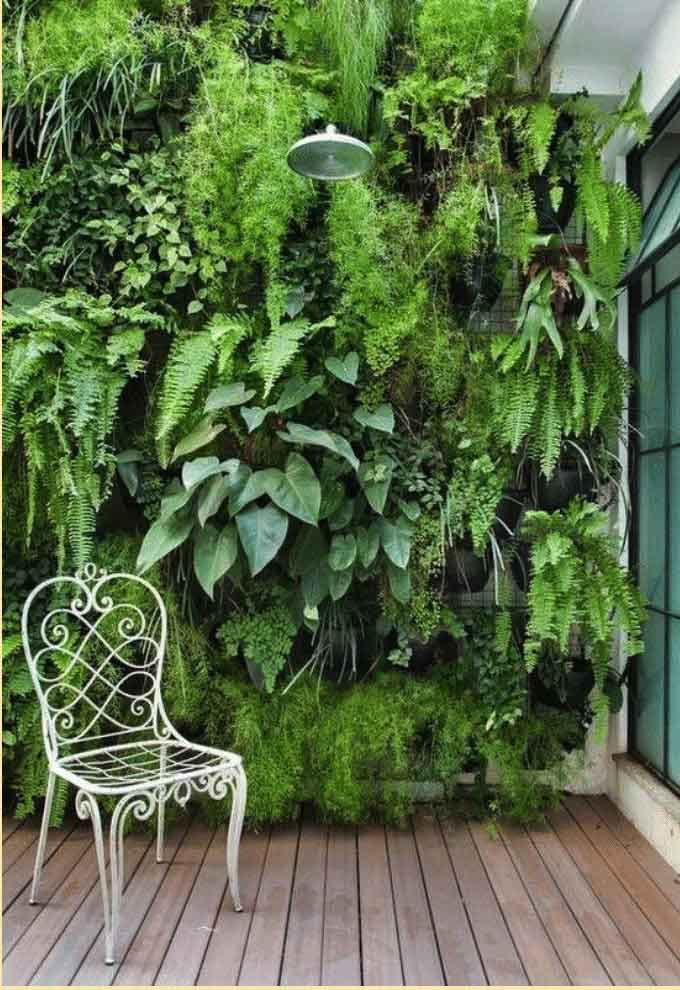
You can use pallets as wall planters.
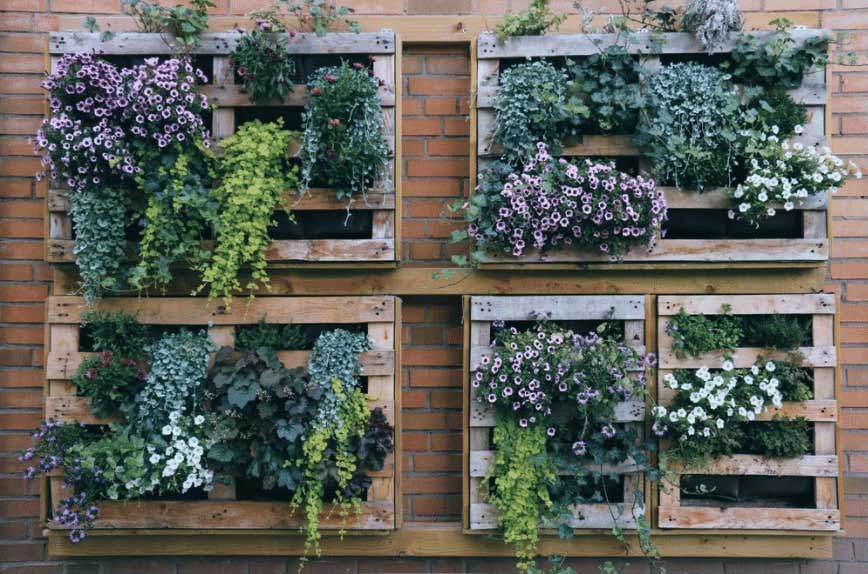
You can use climbers and colourful flowering plants to brighten up your space
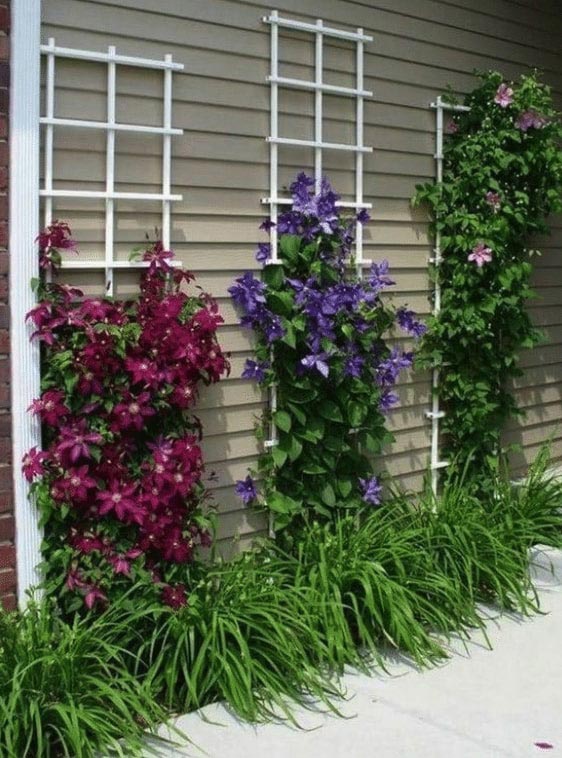
Or you can simply take advantage of trailing plants and create a lush green wall without much work –there are many hanging plants, like Devils Ivy that are also very low maintenance!
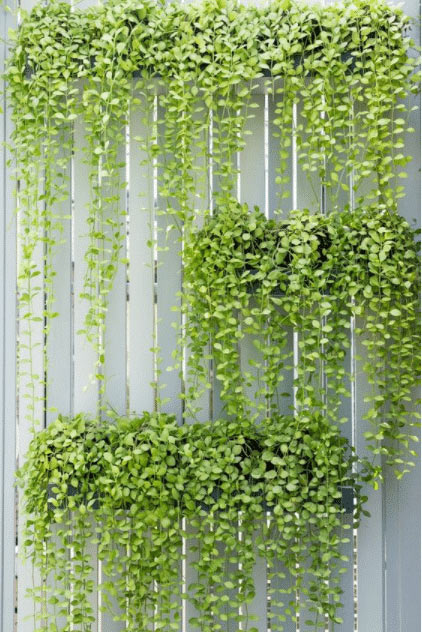
2. Layer Plants
Selecting different plants and layering them with varying heights can make it seem like your front yard is much more spacious than it actually is – while adding privacy and interest to your space.
If your front garden space isn’t large, use layering to create an illusion of a bigger space.
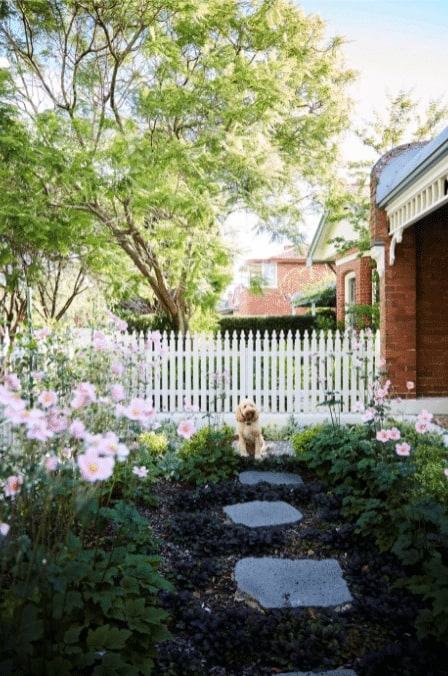
3. Swinging Chairs
Adding a garden chair, swing seat, or hammock is a fun twist to your outdoor space, is a low maintenance front garden idea.
It’s a very cozy setting and an excellent way for you to spend your lazy Perth summer days outdoors with a book or a chilly night gazing at the stars.
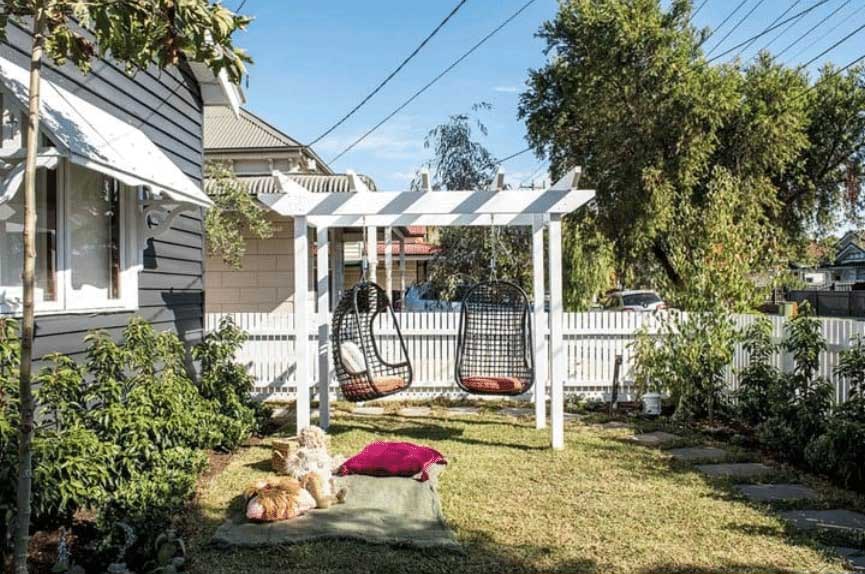
4. Outdoor Table Set
We live in sunny Perth, so an outdoor eating and entertaining area is a must and adds a comfortable, homey vibe to your front garden.
You can go for the traditional outdoor sitting arrangement for enjoying a coffee in the sun.
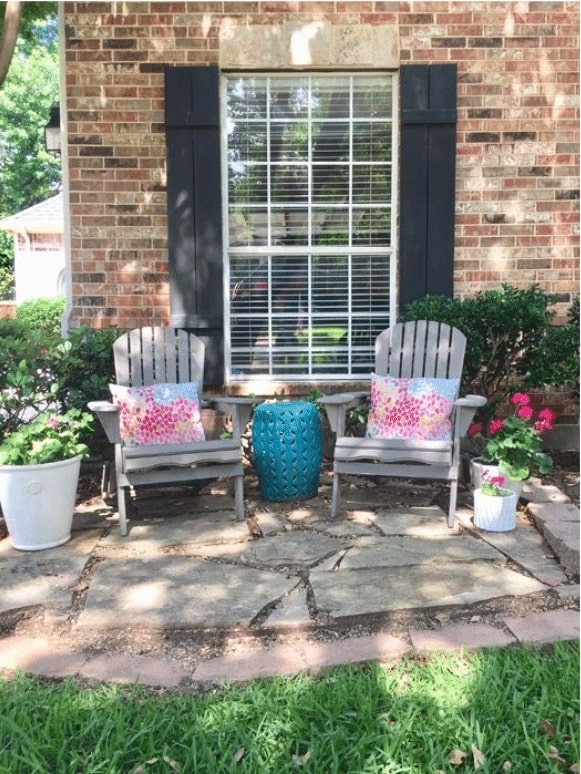
Or maybe you can try to be a little creative with your sitting space and use decking and throw pillows for a more minimal, versatile sitting and hangout area.
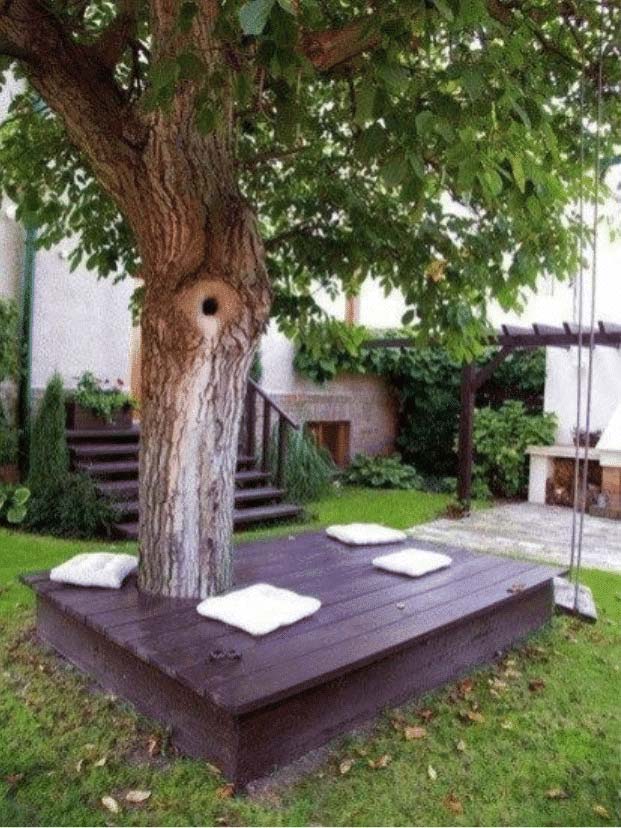
5. Pathway
Create an entrance that welcomes visitors and keeps shoes clean and dry with a pathway that also complements the look of your front garden design. There are so many materials, from gravel to paving stones and pebbles that can make your pathway not just functional but a feature of the front of your home.
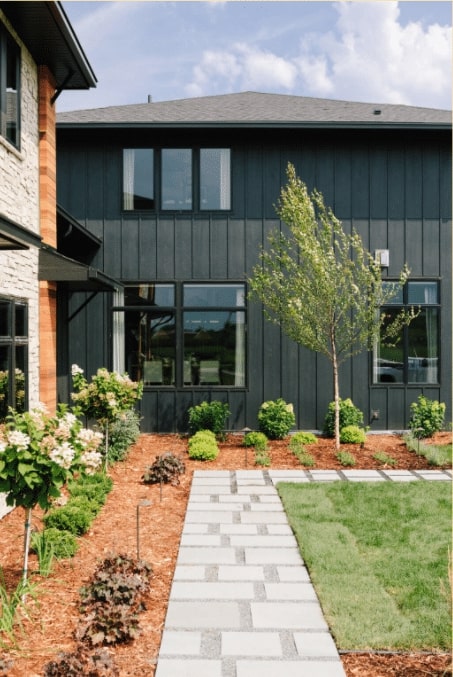
Using stepping stones and pavers is, by far, one of the best ways to build an elegant pathway to your front door and is a great way to use colours that will complement the theme of your garden or home decor.

6. Garden Ponds
Building a small pond in your front garden is not as complicated as you may think.
You can build a pretty little pond right next to your front porch and make it look even more aesthetically pleasing by using different kinds of pebbles and plants.
While you may choose to add fish to your pond, it will require more effort and maintenance on your part, with regular cleaning and care required. Just a pond on it’s own, surrounded by greenery that bubbles and creates the sounds of running water makes a great feature and a relaxing addition to any garden.
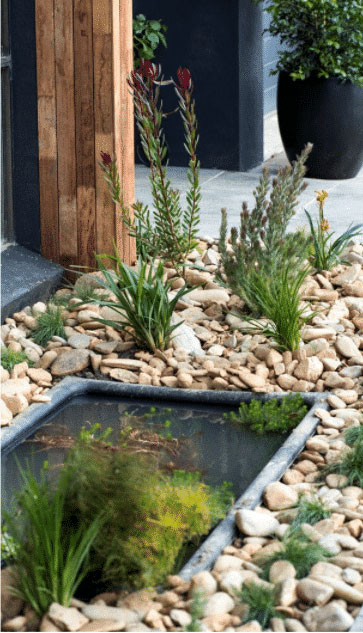
7. Water Fountains
If a pond isn’t for you, there are many water fountains that basically take care of themselves and make a striking addition to your garden while creating audible soothing water sounds. Water is an extremely soothing element to add to your front garden.
So, if you’re looking for low maintenance front garden ideas that incorporate water into your front garden design, just google garden water features, and you’ll get fantastic inspirations like this one.
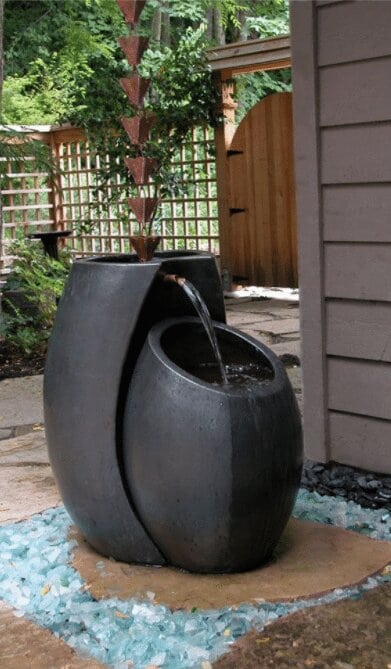
8. Creative Centrepieces
Instead of trying to come up with something extravagant, if you have a small garden, just create a beautiful centrepiece by planting a large bowl with low maintenance plants like succulents that can dress up an outdoor table or corner of your outdoor area.
Even this simple combination of water, rocks, and greenery in a large bowl can add interest and become its own feature in your garden area.

9. Modern Lighting
Give your front yard an elegant look with modern and creative lights to add highlights to certain areas or plants and make your garden a stunning place to enjoy at night.
These days, there are so many inventive outdoor lights that you can choose from, which means you can easily pick out something that’s unique and suits your area and budget
Built-in lighting is a great option and a more subtle way to make walking outside at night safer while showcasing the shapes and elements of your garden.
From illuminating your pathway, spotlighting along your garden beds or including built-in lighting around your deck, we love what garden lighting brings to a space.
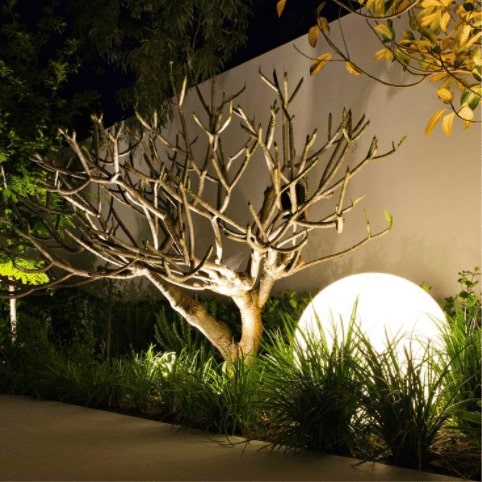
10. Natural Materials
Don’t just think plants or concrete when creating your front garden, mixing natural elements like stone and wood add interest and add a softer, more natural feel to your front garden design.
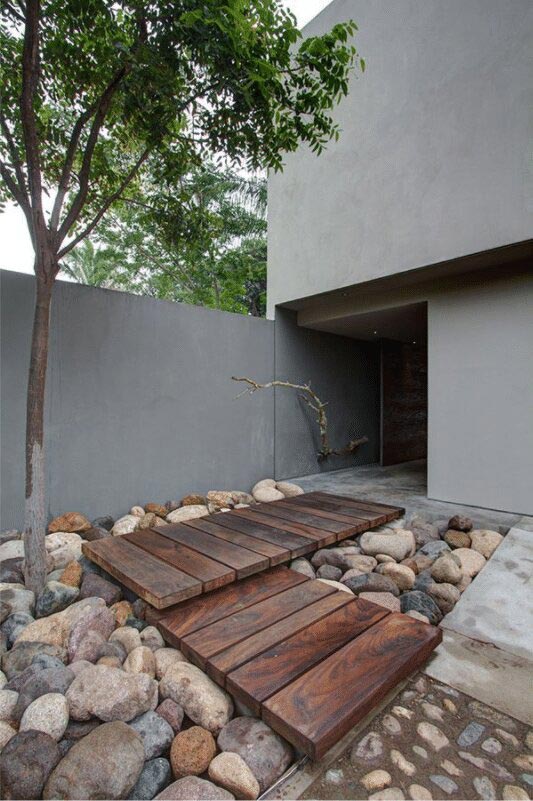
You can add a few touches of greenery and water to complete the landscape for a very low maintenance front yard that still looks striking.
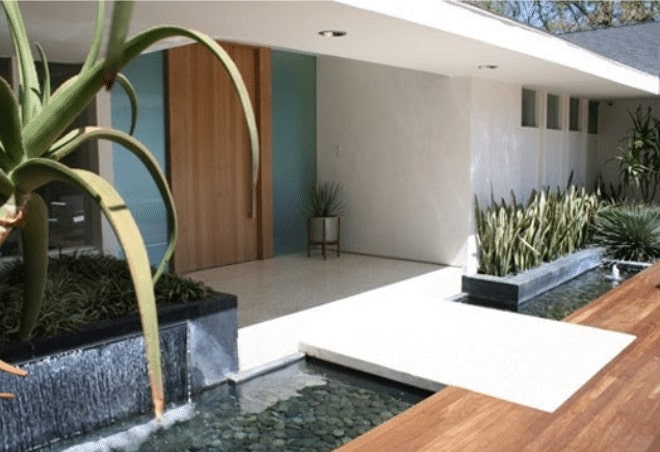
11. Use Every Corner
If you want more space for the kids or pets to play, use the nooks and crannies around your home for creating spots of colour with plants, pots and other garden elements. Front garden design ideas like these, leave the majority of your space free for lawn, while still creating interest and a beautiful garden area to enjoy.
This allows you to keep the rest of your front yard minimalistic while adding a little bit of flair.
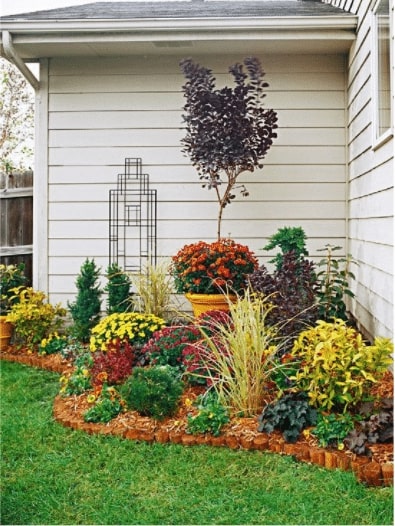
12. Pot Plant Staging
Turn the humble pot plant into a beautiful garden feature by mixing sizes and shapes to create a layered look.
Our top tips – don’t choose an even number; go with either three or five pots. Odd numbers create interest. For a minimal look, have a single plant in each, or pack tall, medium and hanging plants in each pot for a lush, abundant look – this look is our favourite.
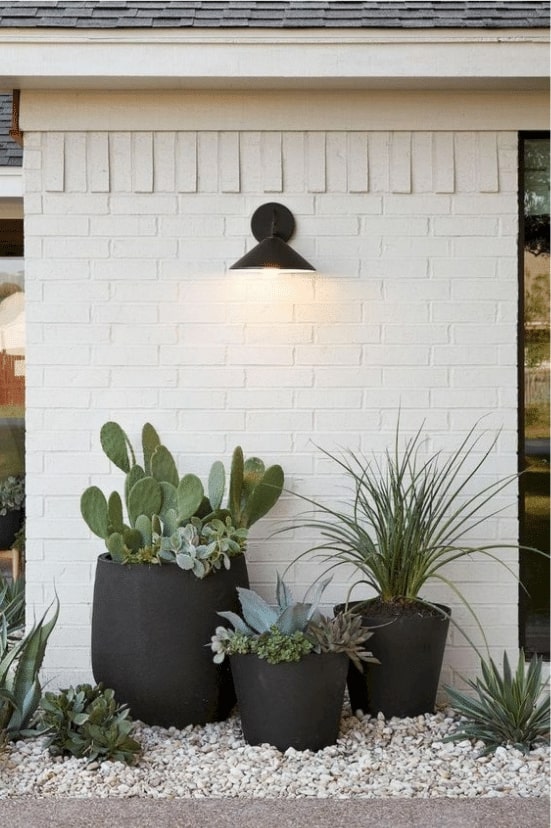
And those are our best front garden ideas to help you get inspired from and create a perfect front yard for your home!
If you want someone to help you create or refresh your front garden, get in touch with us, and we’ll create a yard that’ll be the talk of the entire neighborhood.
]]>Building a small garden can often take more effort than a large garden. Why?
Because it requires clever and thoughtful planning to get the most out of compact spaces.
While creating a small backyard garden, the important thing is to ensure that your garden doesn’t feel cramped or cluttered.
In this blog post, we’ll give you ideas, tips, and techniques to build a functional outdoor space that looks breathtaking all year round.
5 Best Small Garden Ideas For Your Outdoor Space
1. Create a plan
A well-designed garden provides beauty and a functional space that can improve your lifestyle. To get the most out of your small garden, in-depth research and planning are the key to a successful project.
There are a plethora of small garden design ideas on Pinterest that you can use as an inspiration to find your preferred garden style.
First, spend some time understanding what you need from your space and what you will use your backyard for – entertaining, kids/pets play area, relaxing, etc – and define your budget and then create your plan around these two key factors.
Visualise your garden plan on paper first if possible -t’s easier and much less expensive to correct a mistake on paper.
Measure your backyard and take note of problems that you may need to resolve. Does your drainage system need to be revamped? Does your garden not include a shaded area large enough for you to build your sitting space?
Survey the area that receives the most sunlight and plan your planting areas accordingly.
If you want more from less space and don’t want to dedicate your small backyard garden entirely to plants and flowers, make it multi-purpose.
You can have your standard dining area and create a romantic setting with a swing chair and string lights.
And, of course, you have your garden, too.
2. Keep Plants Vertical, Not Horizontal
In small spaces, less is always more. So instead of trying to cram plants on the garden floor, spruce up your wall, maybe use some climbing plants.
Vertical gardens are extremely practical, especially in small spaces.
This gives an excellent illusion of being surrounded by greenery every time you’re in your garden, and it doesn’t take up the much-needed space.
Try adding one big pot instead of several small potted plants, this helps with reducing visual clutter and makes your small garden landscape look more spacious and elegant.
3. Create a Backyard Focal Point
Creating a sitting space at the end of a narrow garden will create an illusion of a larger area.
Position your furniture at the back of a paved area and build a pathway leading to this sitting space to draw attention to this space.
This is a great alternative to a common method of creating your focal point in the centre of your garden. Use the rule of thirds; plan your focal point on the left-third or right-third of your garden (typically away from the entrance).
One tip to make your garden look bigger is by taking advantage of optical illusions with a contemporary garden mirror panel.
4. Choose the Right Plants
Take advantage of foliage and the texture of tropical plants. Plants with large leaves like the Elephant Ear plant will change the scale of your small backyard space.
You can create a sense of depth in your small garden with your plant selection. You can do this by simply playing with the heights of different plants to create a layered look.
You can try layering colour, too – you can either include gradations (reds, oranges, and yellows) or go for a classic combination like red and purple.
If you want, you can even stick to one variety when it comes to your flowering plants, for example. It gives your small backyard garden a consistent aesthetic and reduces the work you have to do to maintain your plants.
5. Choose the Right Furniture
Get functional furniture for your outdoor space that helps you save space by doubling as a storage unit for things like your gardening tools.
Use portable furniture that you can effortlessly bring out, put away, and roll around (coffee table on wheels) as and when you need them. Choose flexible pieces of furniture like collapsible tables and foldable chairs that can be easily stored.
Hang furniture to create an illusion of more floor space. All you need is a nook of your garden to mount a hanging chair and make it your own cozy reading corner.
You can even hang a relaxing hammock under shade for a lazy afternoon nap. When not in use, you can simply hang both ends from the same hook and make use of the additional space.
If you don’t have a shaded area in your garden, you can easily create it with a large patio umbrella.
You can also use perspective to add different levels to your garden.
Raised garden beds, sunken fire pits, and a raised platform will open up more creative ways for you to optimise your small backyard garden area.
You can even stack container plants on multiple levels to add dimension. You can integrate large terracotta with slender and tall glazed pots.
Outdoor fireplaces are even more suited for small backyard gardens than large ones because they bring in an element of coziness and intimacy.
And that’s it!
Those are our 5 best small garden ideas to help you get inspired and create a perfect backyard!
Want more? Here for some simple front garden landscaping ideas.
If you want someone to help you install your new garden, get in touch with us, and we can supply and install your new plants, garden beds and mulching, etc. Together, we’ll create a yard that’ll amaze your entire neighbourhood.
]]>You don’t need a big area to create a lush, colourful tropical garden.
When it comes to creating a tropical garden in Perth, there are a few things you should know first…
How to prepare your garden for tropical planting
A key consideration when planning a tropical garden is that the climate here in Perth is very dry. To create your lush tropical garden, you will need to have a proper irrigation system to enable your tropical plants to thrive. They need much more water than our native plants, and won’t handle drought conditions without help, so adding a carefully designed reticulation system is crucial.
Preparing your soil is the other key element to a successful tropical garden. Here in Perth, we have very sandy soils and sand is not necessarily the best growing medium for most tropical plants. To give them the best chance of first establishing when planted, then thriving for years to come, you will have to carefully improve your soil before planting. This is best to speak to an expert about so they can check the nutrient levels in your soil and apply the right amounts and balance of improvers for the plants you want.
Best tropical garden plants for Perth gardens.
When you know the right tropical garden plants for creating the tropical look in a climate like Perth, your garden will have a better chance of success.
This is why we’ve created a list of low-maintenance tropical garden plants that you can grow in your garden here in Perth.
Blanchet’s Aechmea – ‘Aechmea blanchetiana’
This is quite a large plant and grows a more intense shade of orange depending on the amount of sun it receives.
When it starts flowering, the mother plant begins to die and starts to grow new offsets around the base of the plant. These offsets get their nutrients from the dying plant, and once they grow about a third of the plant, you can replant them in different spaces in your garden.
The leaves have sharp backward-facing spines along their edges, so we recommend using gloves while handling this plant.
When you replant the offsets, take care not to plant them too deep into the soil as this can cause them to die.
Don’t overwater these plants. It prefers dry to damp soil as too much moisture can cause the plant to rot.
Slender Weavers – ‘Bambusa textilis’
Slender Weavers is a type of Clumping Bamboo that has very thick and upright growing canes.
It is ideal for tight spaces and gives you an instant tropical feel while adding privacy because it grows super-fast.
You can plant them on the edge of your garden to get a lush-green privacy screen. It’s the king of screening plants for it can grow up to 6 m in height with full sun or part shade and a splash of water.
Crotons
If you want to focus on adding more color to your garden primarily, crotons are an excellent option.
There are several different species and cultivars, and they are known for their easy maintenance and colorful foliage. They will add a multitude of colors to your garden like orange, red, yellow, and even bright lime green!
If you have a hole in your garden, you can use these shrubs to fill up such spots in your garden.
They require extra care during the winter season as they are frost tender. To protect the roots from cold, mulch with organic materials for at least 2 inches (5 cm) around the plant.
You can also grow them in potted containers so that you can simply keep them inside during the winter until the first warm rays of spring.
Bird of Paradise – ‘Strelitzia’
This majestic plant is well known for its palm-like leaves and vibrant flowers that look like tropical birds when they bloom. As you may have guessed, the flowers are why it gets the name ‘Bird of Paradise.’
It can grow up to 1.3 to 1.5 m tall and spread up to 2 to 3 m.
Strelitzia has three species: reginae, juncea, and nicola; and you can use them all to elevate the beauty of your garden.
Keep the plant in a warm and sunny section of your garden, and only water the plant when the soil feels dry.
One important thing to note is that if eaten, this plant is poisonous to cats and dogs. So if you have a pet who has a habit of chewing your plants, you may not want this in your garden.
Cordyline Palm – ‘Cordyline fruticosa’
It is a perennial, broadleaf evergreen plant that can grow up to 8 to 10 m tall and spread up to 1 to 2.5 m.
It is striking and glossy with streaks of pink, green, purple, and red-colored leaves.
While this plant typically doesn’t bloom indoors, it grows small and fragrant flowers outdoors during the spring. The shade of these flowers ranges from white, yellow, reddish to pale lavender.
Plant it in well-drained soil and water it only when the soil has dried out.
To bring out the intense shade of the leaves, expose the plant to full sunlight.
While those are our best tropical plant suggestions for your garden, here are a few other low-maintenance tropical garden plants you can consider.
- Golden Cane Palm
- Dracaena Marginata (Dragon Tree)
- Sago palm (Cycas revoluta)
- Variegated Ginger
- Hawaiian Hibiscus (Hibiscus rosa-sinensis)
- Alcantarea Giant Bromeliad
- Dancing ladies (Oncidium species)
- Cordyline Fruticosa Rubra
- Cordyline Fruticosa Negra
- Spiral ginger (Cheilocostus speciosus)
- Bromeliad Neoregelia
- Philodendron Xanadu
One thing you need to keep in mind when you are creating a tropical, or any garden, is that you’re also planting for the future, not today.
However lovely it looks now, it will look even more beautiful after it grows into itself and the plants really establish.
Plan out how you will use your space and consider your current lifestyle and budget before you start building your tropical garden.
If you need help with soil improvement or want garden professionals to supply and install your chosen tropical plants, we’d be happy to help.
No idea where to start?
From design to installation, if you need any help building your dream tropical garden, you can find out more and get in touch with us here.
]]>When you have a garden, there is undoubtedly going to be some maintenance involved, whether you like it or not.
But lucky for you, there are many ways to build an easy maintenance garden so that you spend less time working and more time enjoying the outdoors.
While some may think they would have to live with a simple garden if they want fewer chores, we don’t believe you should compromise style for an easy gardening life.
This is why we’ve put together this blog post with our 9 top tips for creating low-maintenance gardens here in Perth.
1. Plan Your Garden.
If you want to create a garden that doesn’t require too much work to maintain, it’s important to take the time to think about what you want and need, along with your lifestyle so you can plan the right elements to include in your garden design.
A great way to minimise maintenance is to create outdoor living areas that utilise paving or concrete for weed and maintenance-free areas that also encourage you to spend more time outside.
This way, you can enjoy your outdoors and entertain with friends and family, and focus your time and attention on maintaining specific garden areas that add greenery and look beautiful while taking much less work because you aren’t maintaining your entire outdoor area.
By decreasing the size of your lawn, you have less mowing, weeding, pest control, fertilizing, and reseeding to do.
2. Choose the right plants.
If you want a really low-maintenance garden then you need choose native plants in your garden. Gardens that include a lot of tropical or non-native plants will always need more TLC in order to survive our particular Perth climate and soils.
Native plants have evolved and adapted to the climate and insects of our West Australian region, which means you won’t have to baby them as you would have to if you go for other plants that aren’t native to our area.
These easy-care beauties don’t need much effort from us to survive and thrive.
3. Remember to Mulch!
Weeding can be a soul-breaking garden task, so mulching is an excellent way to cut down on the amount of work you need to do to stay on top of your weed control.
Mulching is when you lay a thick layer of chunky material around your plants, this can be done using organic materials such as wood chips or Pine Bark or by using inorganic materials such as gravels.
Not only does this trap the water in, but it also improves your soil texture with minimal effort, reduces the number of weeds growing through and quite importantly, makes the garden looks much tidier.
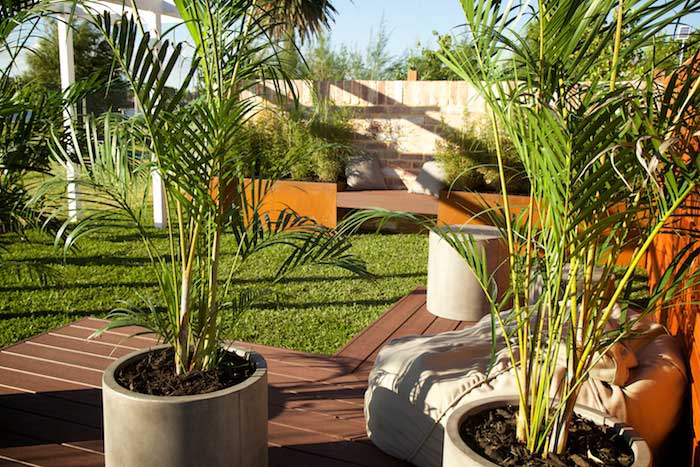
4. Add colour to your garden with flowers
Beautiful and vibrant flowers are always a sight to behold.
There are several resilient flowers that bloom throughout the year and can do so without much deadheading.
Petunias, Cosmos, and Begonias are some of the most beautiful flowers that remain appealing and lively year-round. Evergreen options are also a great way to keep a vibrant, healthy green colour in your garden year-round.
As always, do some research to get a better picture of which flowers suit your region and garden style the best.
5. Raised Garden Beds
Elevating the garden above the ground is one of the smartest decisions you can make if you want low maintenance garden beds.
Not only is it an excellent solution for poor soil conditions, but raised garden beds also are easier to work on since you can group plants that have similar needs.
If your garden soil is like heavy clay, you can take advantage of raised garden beds and create a great environment with new, clean, and fertile soil mixed with compost.
6. Add a handful of container plants.
You can spread these potted plants out throughout the garden. You can even place them by the edge of your stairs or in the shade by choosing plants that don’t need much sunlight to bloom.
You can spice your garden up with stylish, modern, and elegantly designed containers filled with vibrant plants.
Maybe you could match your house decor with these containers and make your garden feel like an extension of your home.
They’re easy to maintain, and you can keep shuffling things up to keep your garden fresh.
7. Self-watering pot plants.
Self-watering pots have become extremely popular these days because of their effectiveness and convenience.
Not only do they cut down on the chores you have to do, but they also keep the plants healthy and save water all year around.
Additionally, since the plants have access to water every second of the day, and the water reservoir bed is layered with mulch, there is less opportunity for weeds to grow.
What more could you ask for?
8. Use groundcover plants
Groundcover plants are an amazing way to transform areas that you don’t want to maintain as lawn or garden beds while still keeping your garden green and beautiful. Do you have an ugly patch of dirt that you need to cover up or gaps between pavers that you need to keep weed free? Ground cover plants are the perfect low-maintenance choice.
With flowering and evergreen options, they can suit all garden designs and styles.
Some great options are:
Star Jasmine
Native Violet
Grevillias
Bush Mint
Pratia
9. Add Gravel to your garden floor.
If you choose to cut out most of your lawn space because you don’t want to spend much time maintaining it, don’t just replace it with hard landscaping.
Instead, install gravel to your garden floor.
This allows the rainwater to drain away without causing any potential flooding. So not only is it low maintenance, it’s very practical.
And that’s it!
Most of the low maintenance garden design plans we’ve mentioned are not just to relieve effort from your end but also budget-friendly.
If you’d like us to do all the heavy-lifting and build the garden of your dreams that is truly maintenance-free, give us a call at 08 6263 4645
]]>Perth Reticulation Experts has recently been recognized for its efforts to offset our carbon emissions and plant trees to support the Australian Native Reforestation.
Read all about it here.
]]>When it comes to selecting the best plants for your pool area in Perth, there are a few key factors to consider. First and foremost, you’ll want to choose plants that are well-suited to the local climate and soil conditions. Perth is known for its hot, dry summers and mild winters, so you’ll want to choose plants that can tolerate these conditions. You’ll also want to consider the amount of sunlight that your pool area receives, as this will help you choose plants that are well-suited to these conditions.
How to Best Plants for Pool Areas
This guide will give you some ideas on how to choose the best plants for pool areas, letting you know some of the most chlorine-tolerant plants, along with what to look out for. This will help you save money and time and make sure you have the best pool plants
Select Litter Free Plants
Try to avoid plants that shed twigs and leaves all year round, so you don’t spend hours sweeping up your pool area before using it. Silky oaks, Illawarra flame trees and jacarandas shed leaves and flowers through the summer, making it a challenge to use your pool. Some plants that won’t drop too many leaves include flax, cordylines and palm trees.
A great litter-free plant for a pool area in Perth is the native grass species, Lomandra. This family of tough, drought-tolerant grasses are perfect for hot, dry areas and can withstand extreme heat and full sun exposure. Some of them, like longifolia do flower, so take that into consideration when planting – flowers in the pool can be annoying! Lomandra’s are a low-maintenance plant that require minimal watering and are resistant to pests and diseases while remaining evergreen. It’s a great choice for creating a natural, informal look around your pool.
Avoid Plants with Extensive Roots
Umbrella trees, bamboo, gum, deciduous trees and rubber trees might look good, but their extensive and sprawling roots can cause unseen damage below the ground with your underground pipes, paving and even the pool shell.
Watch Out For Pollen
Regular maintenance of your pool will make sure that pollen doesn’t cause too much damage to your filtration and cleaning equipment, although it’s impossible to keep all pollen out of the pool. Be sure to regularly clean or replace your baskets, cover your pool while you are away, and attach a fine material such as pantyhose or cheesecloth to your skimmer before cleaning pollen off your pool’s surface.
Pay Attention to New Plants
New plants will need extra care and attention before they are well established, including an initial deepwater planting and during the dryer months, at least twice a month. Plenty of mulch around smaller seedlings and plants will help to protect them from the sun, although you should keep mulch away from the trunk so as to prevent rot. If pool area plants are in direct sun for most of the day, a light shade cloth may be the solution.
Best Poolside Plants for Salt Water Swimming Pools
If you have a swimming pool containing salt water, make a point of planting some salt water tolerant plants in and around your pool area, to ensure they will thrive. Plants that have waxy, furry or silvery leaves are generally ideal if you want plants near your saltwater pool; some good examples of these include cycads, yucca plants, aloe, agaves and bromeliads.
Other plants that don’t mind being splashed by salty water every so often include echiums, pig face, coastal banksia, dianella, agave attenuates, and palms, many of which can be seen in coastal areas.
Best Poolside Plants for Chlorinated Swimming Pools
Some plants can withstand being splashed by chlorinated water better than others, although no plant is truly 100 per cent suited. Think of plants that have larger and leathery leaves, including golden cane palms, erigeron daisy, cordylines, murrayas and star jasmine.
Let Perth Landscaping Help Choose Your Poolside Plants
The most ideal approach to ensure your pool is both lovely and green and a safe and low-maintenance area, is to check your poolside plant selection with an expert landscape designer.
Let us know you’d like a chat with any of our local and qualified landscape designers to help with your pool plant selection and design.
We can advise and consult on your project, or help you start from scratch – just get in touch! Our team at Perth Landscaping would love to help with your pool plan!
]]>